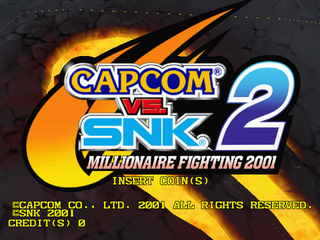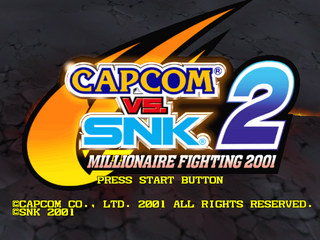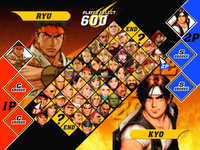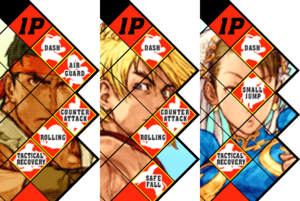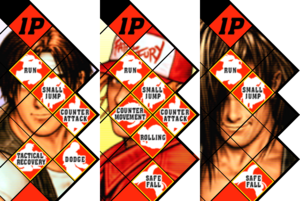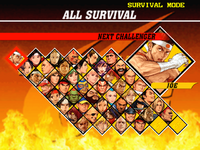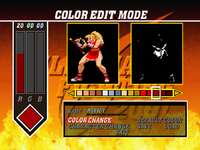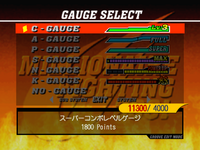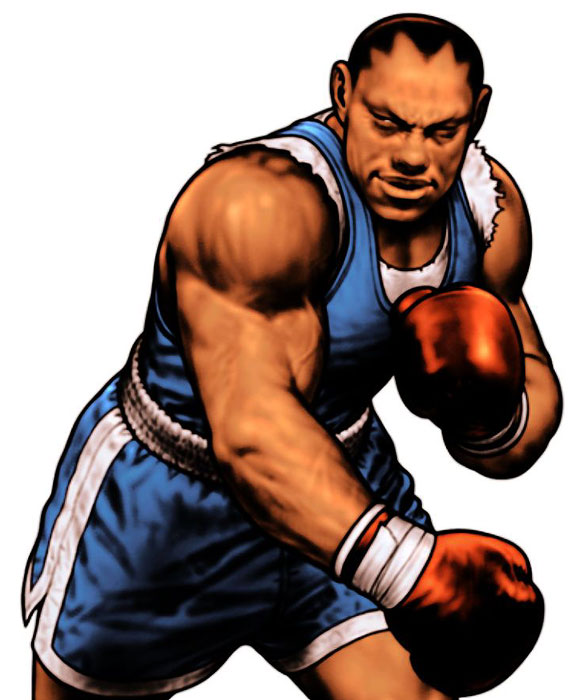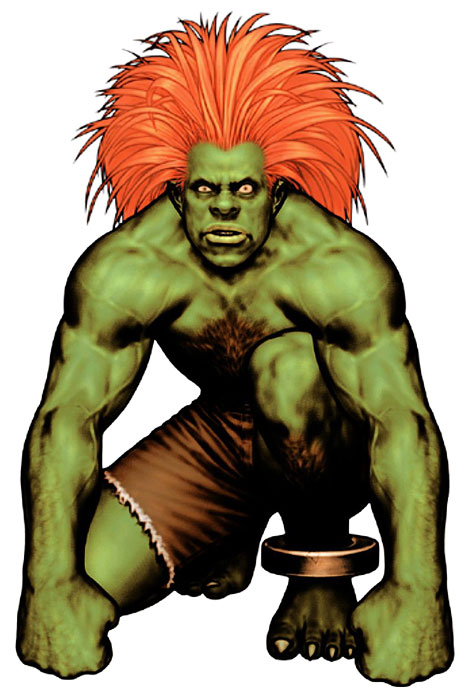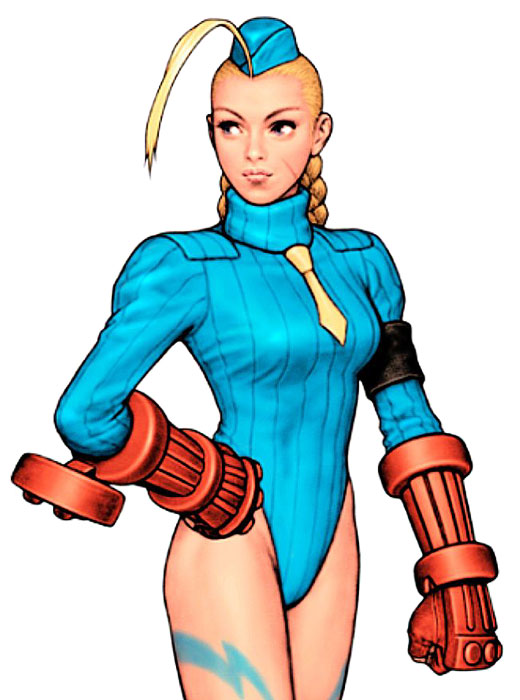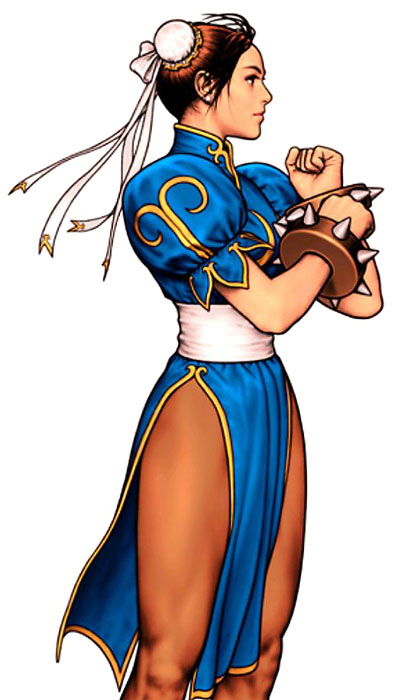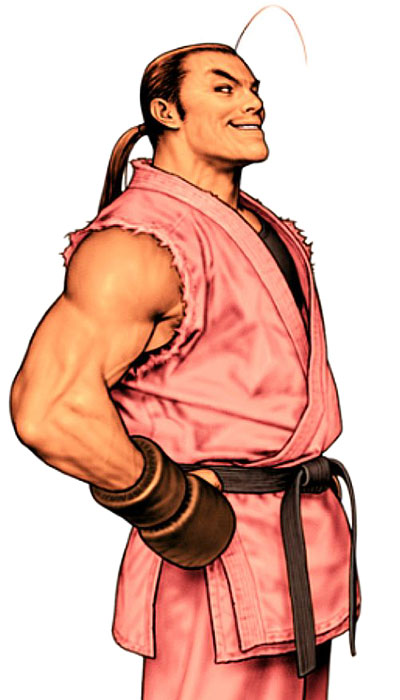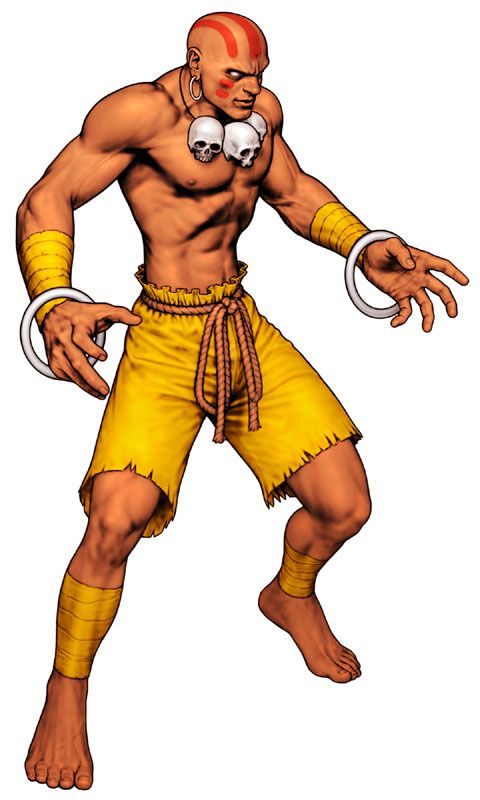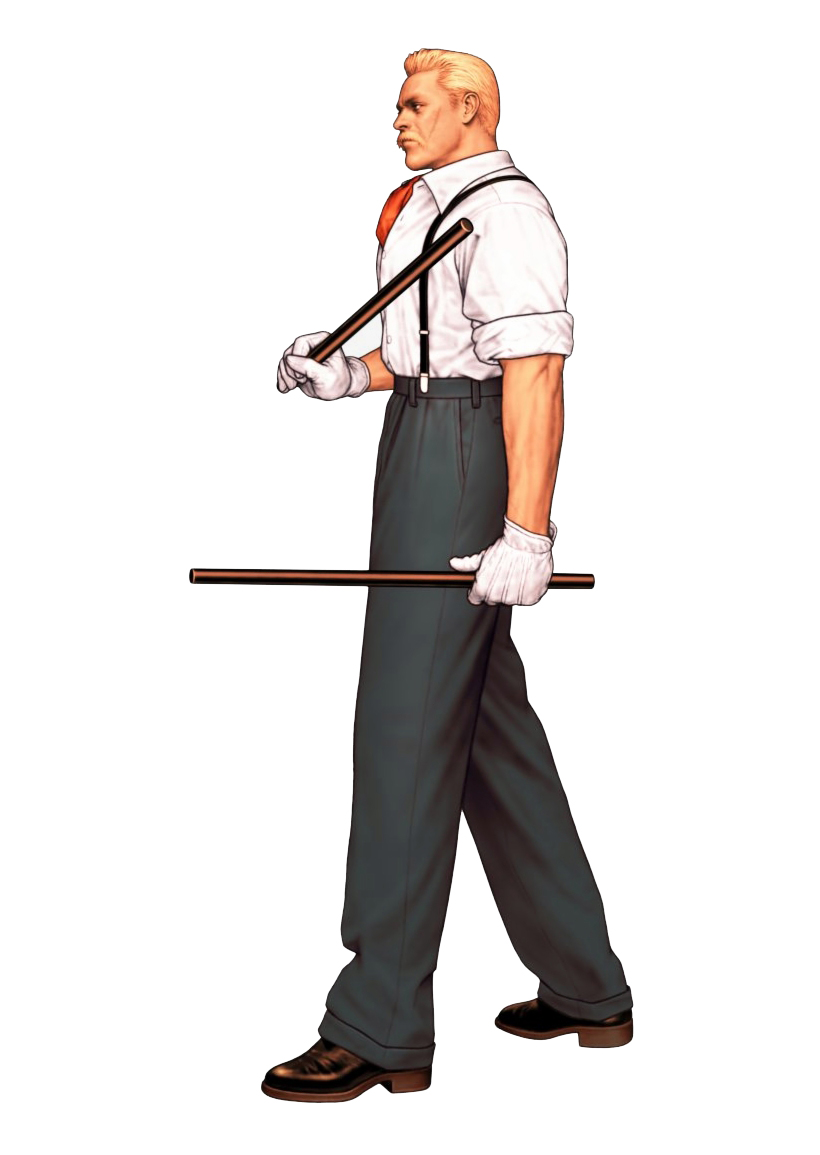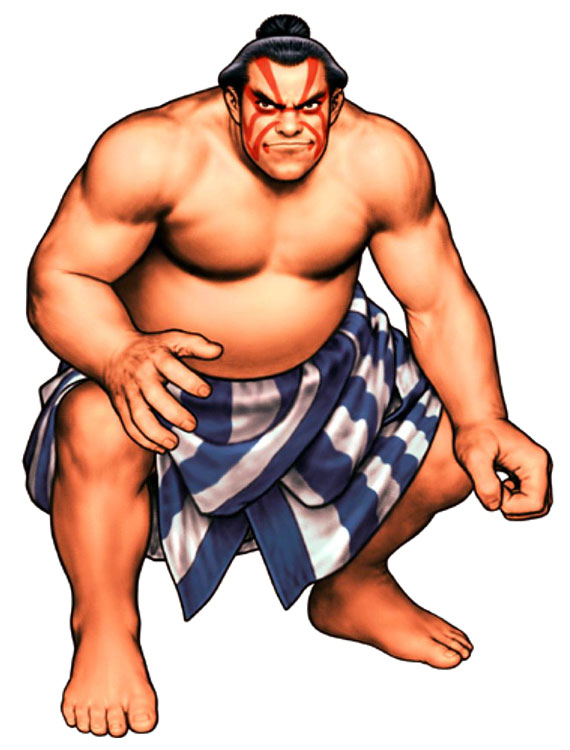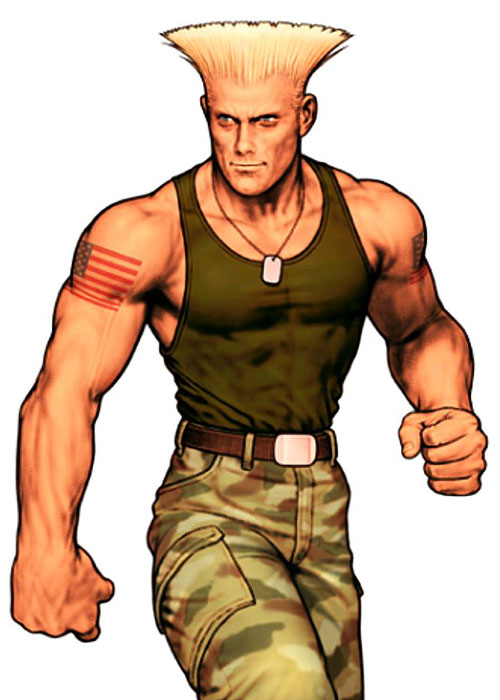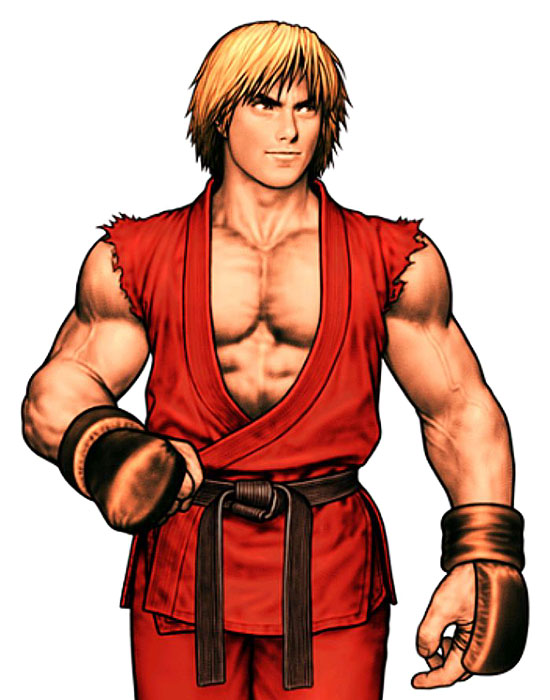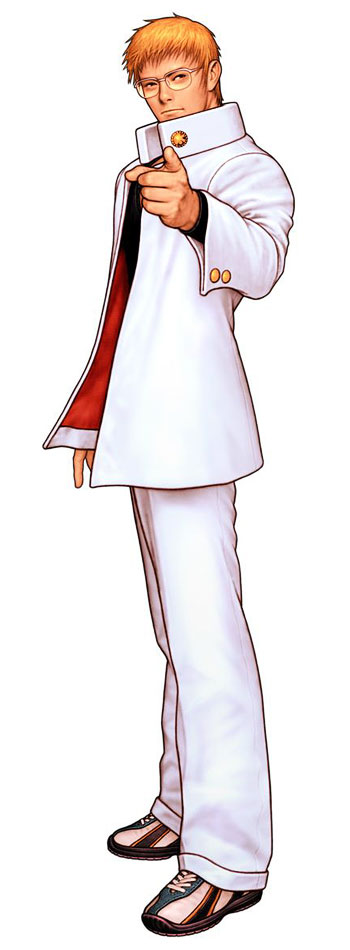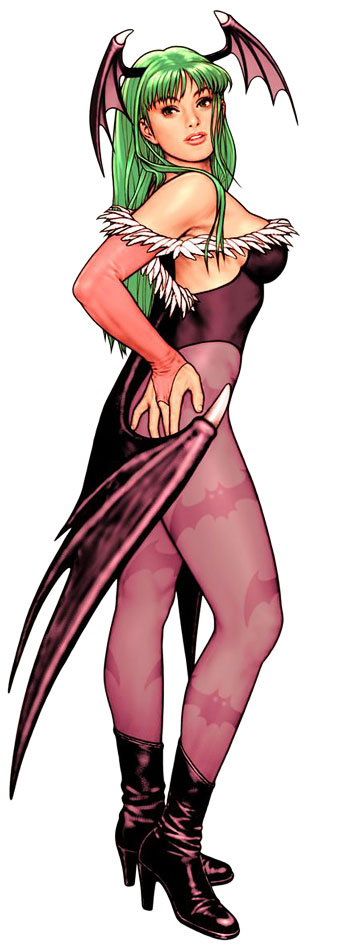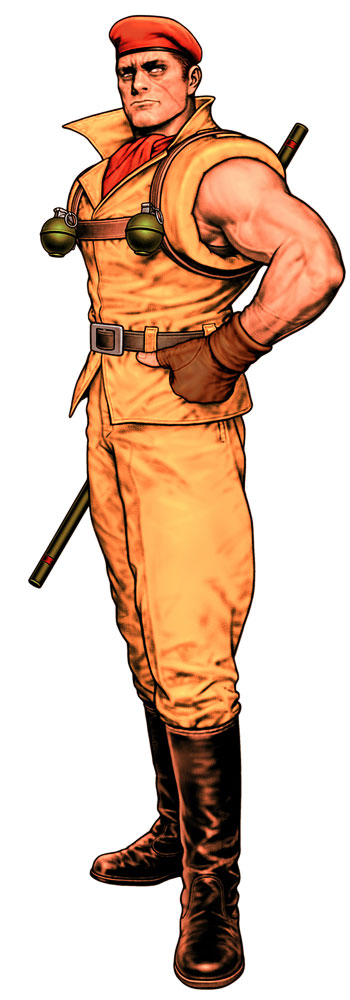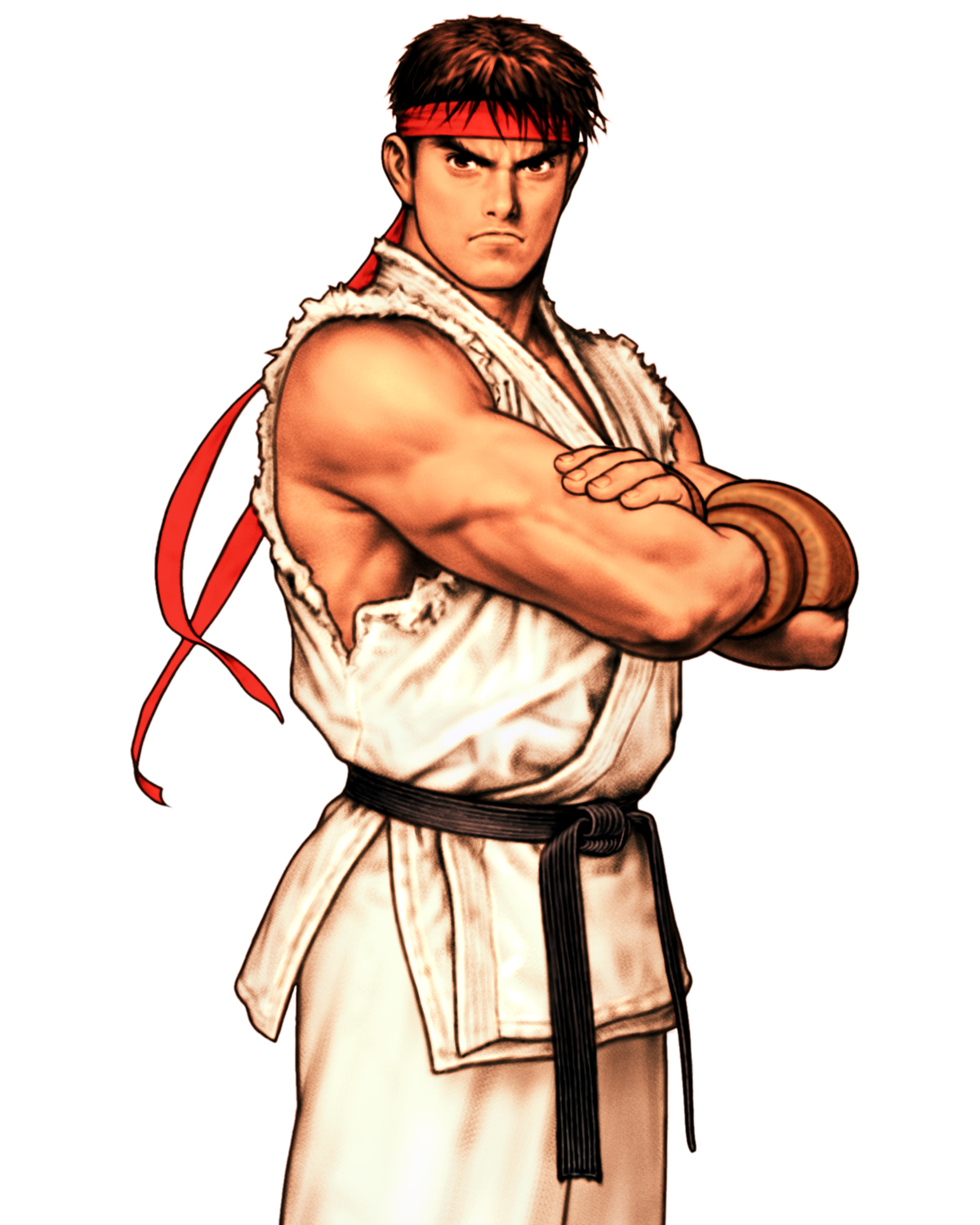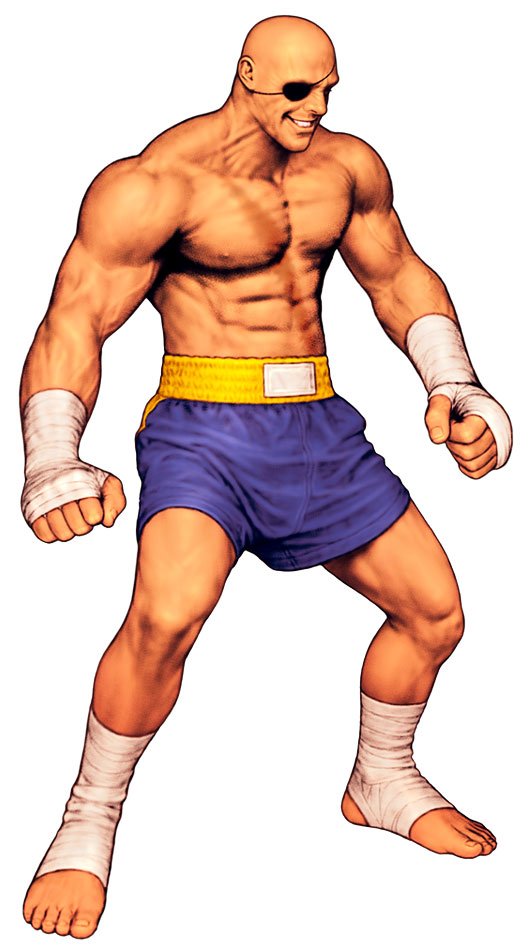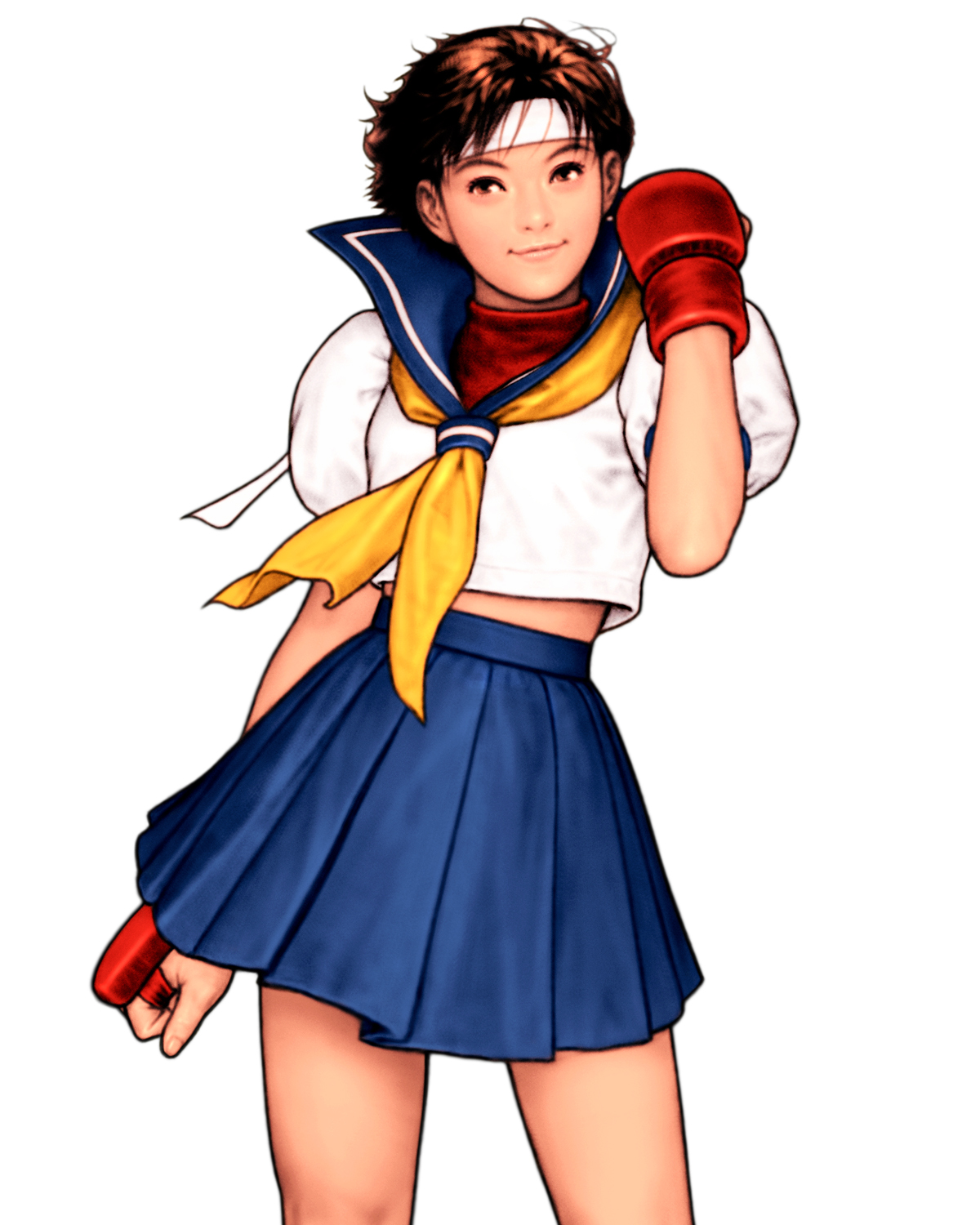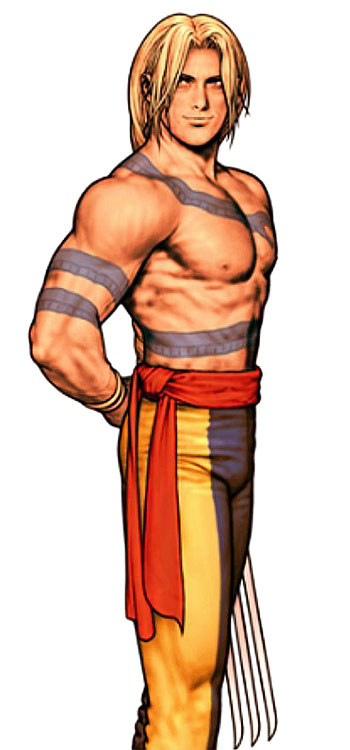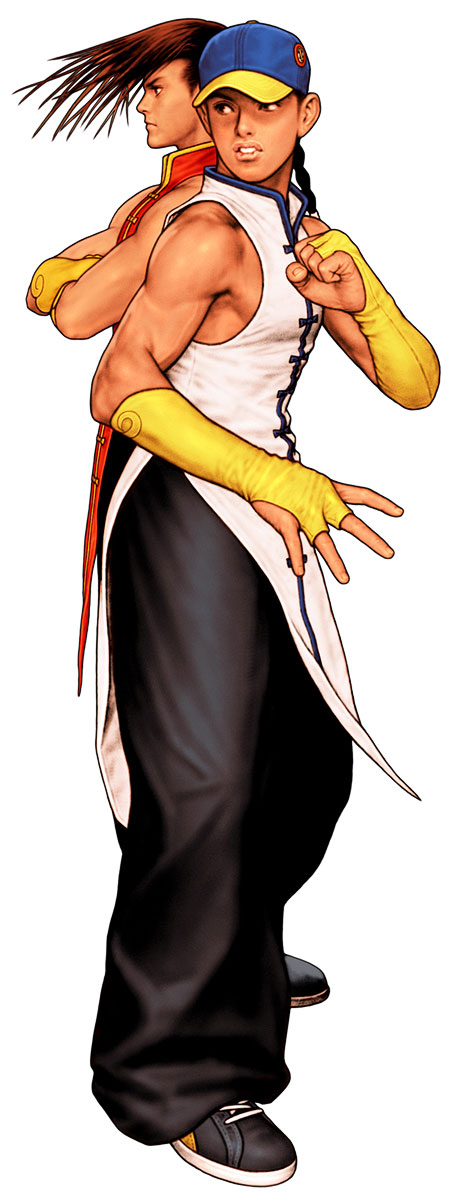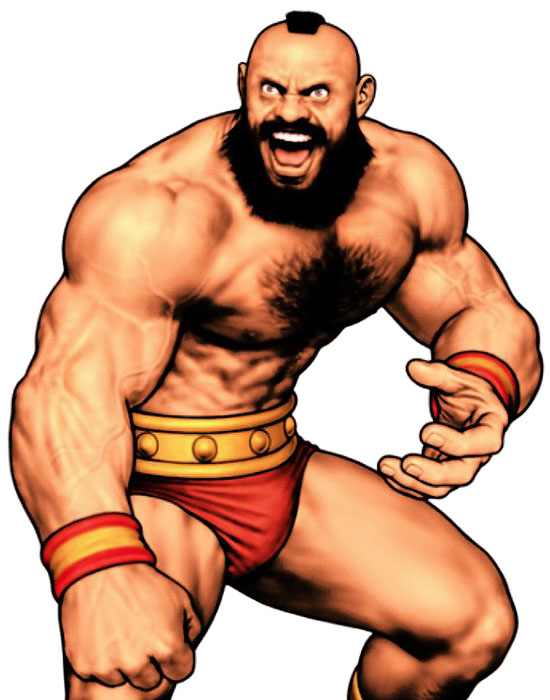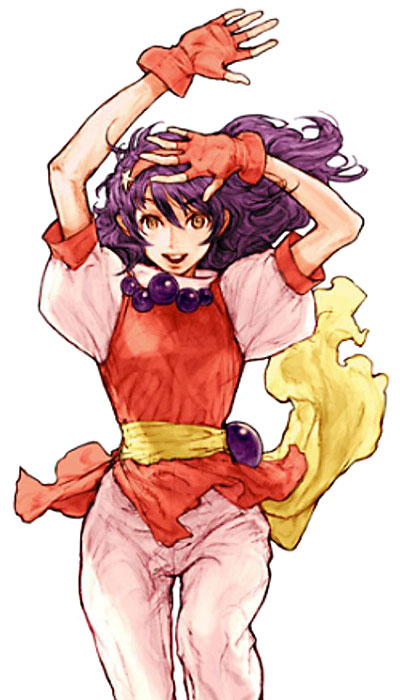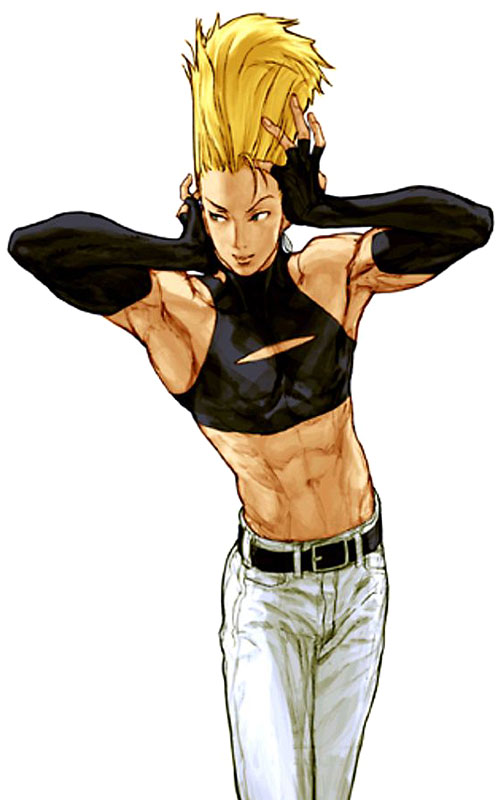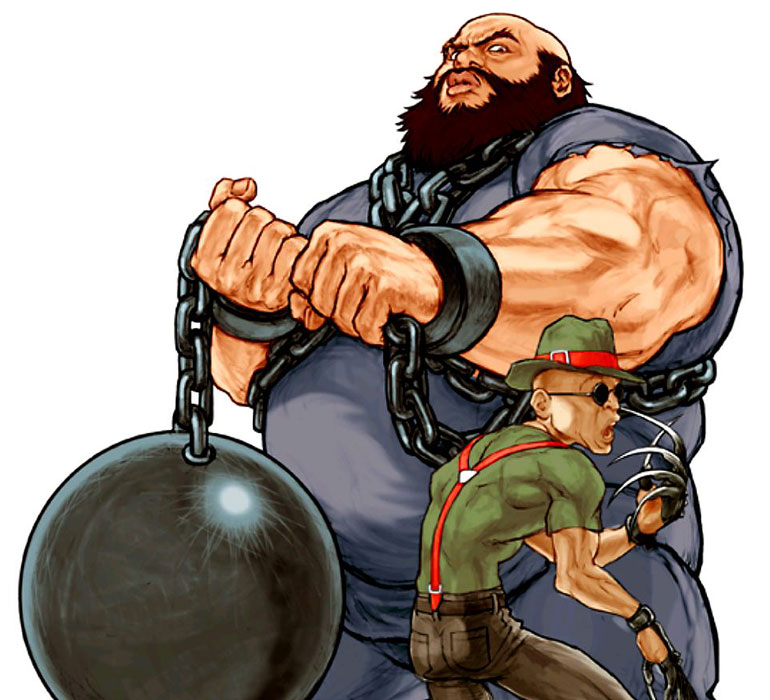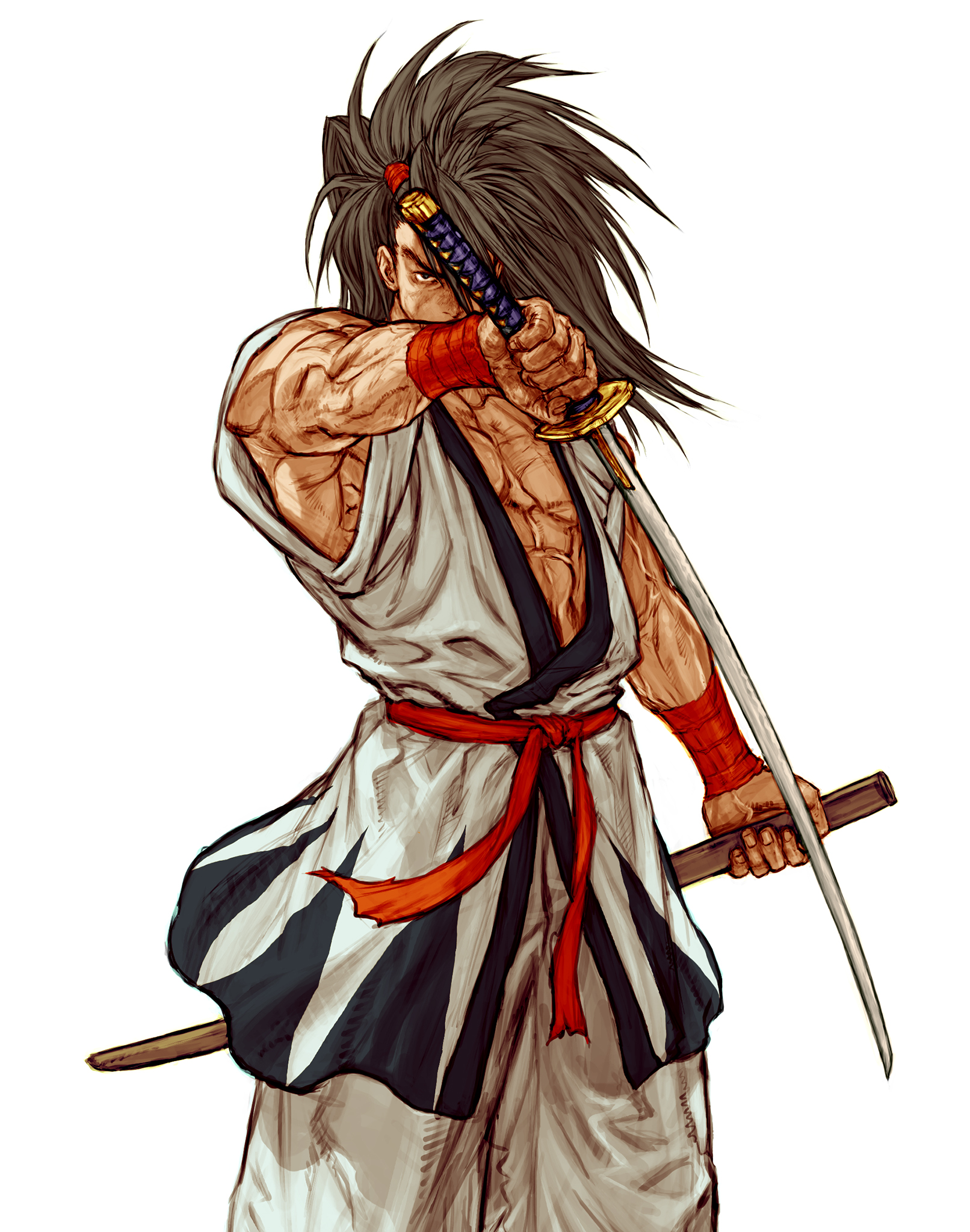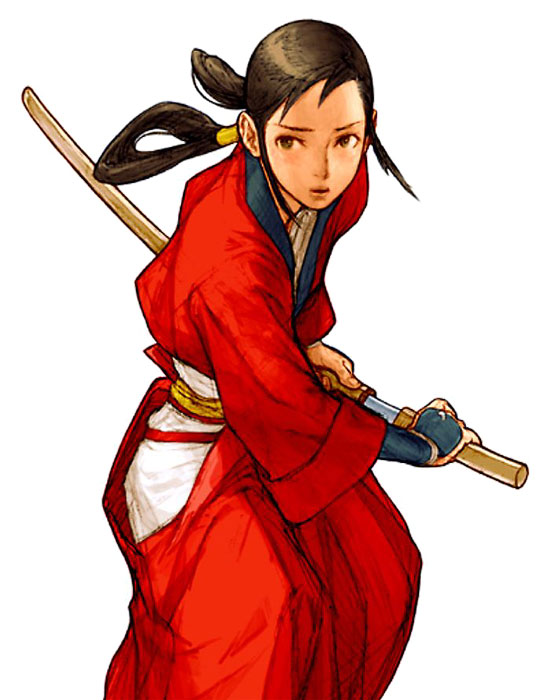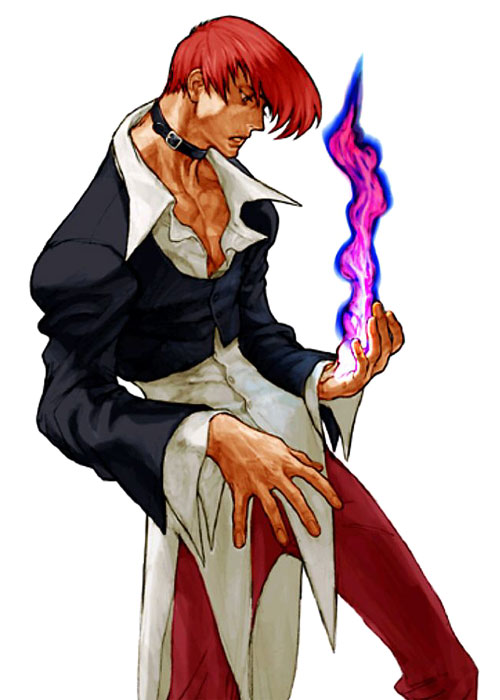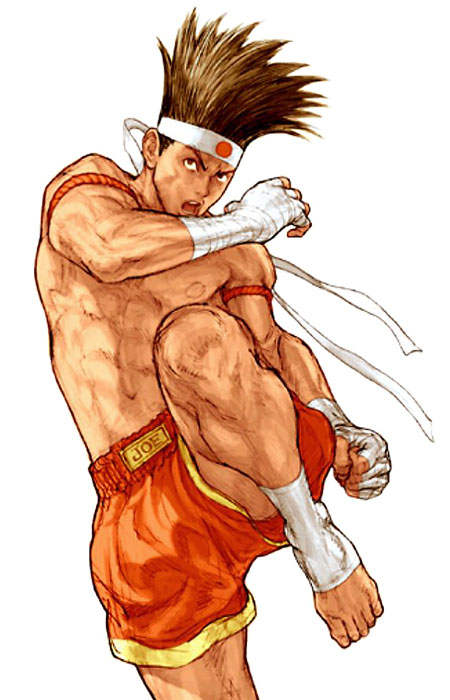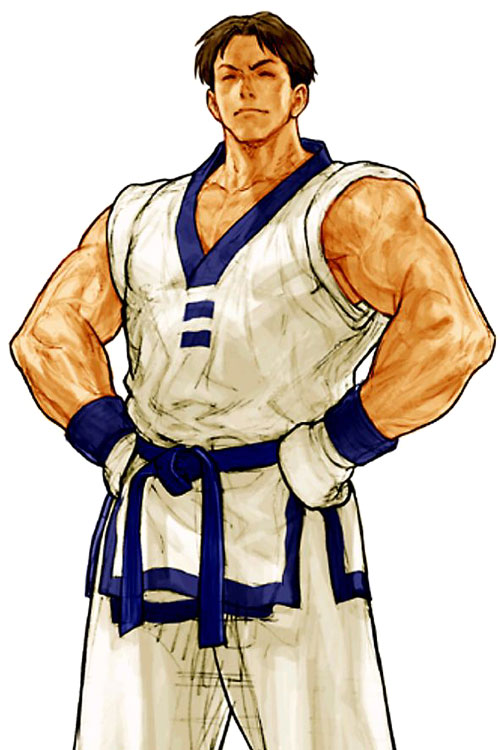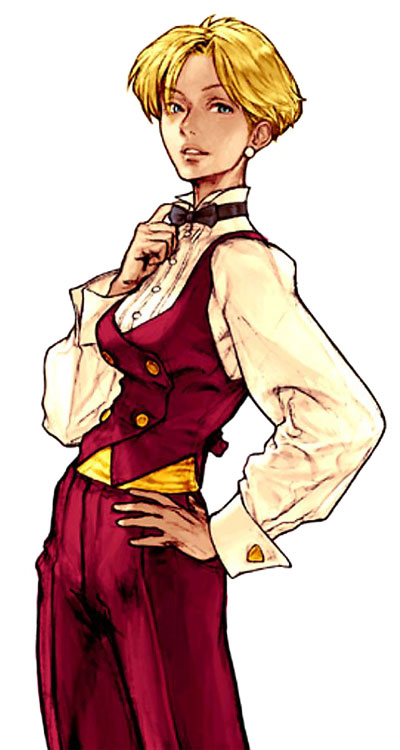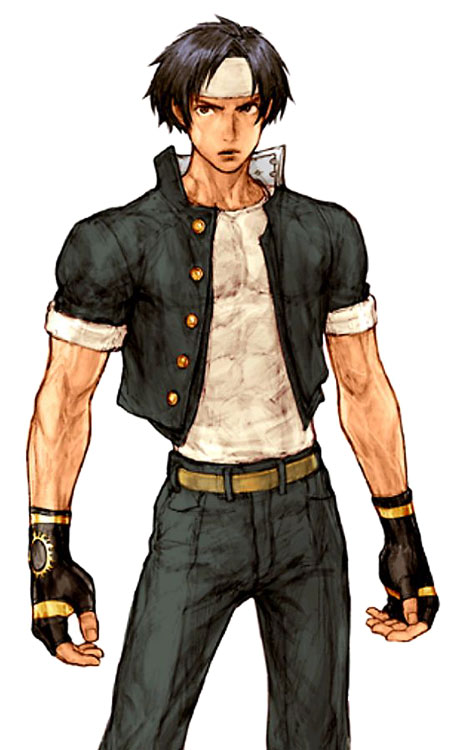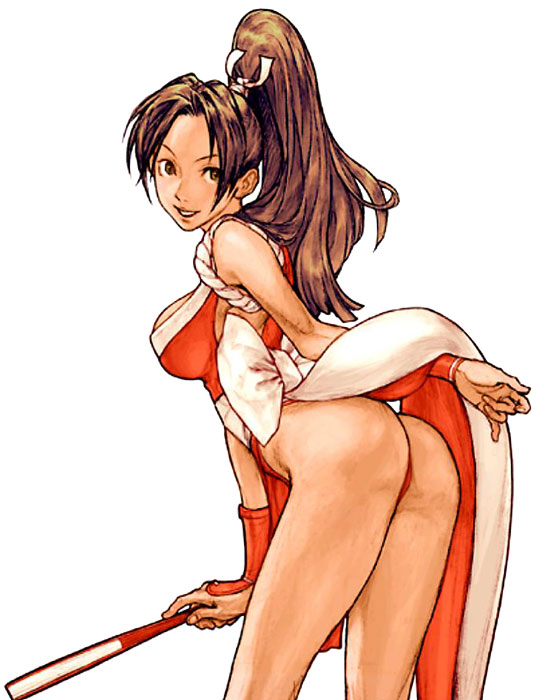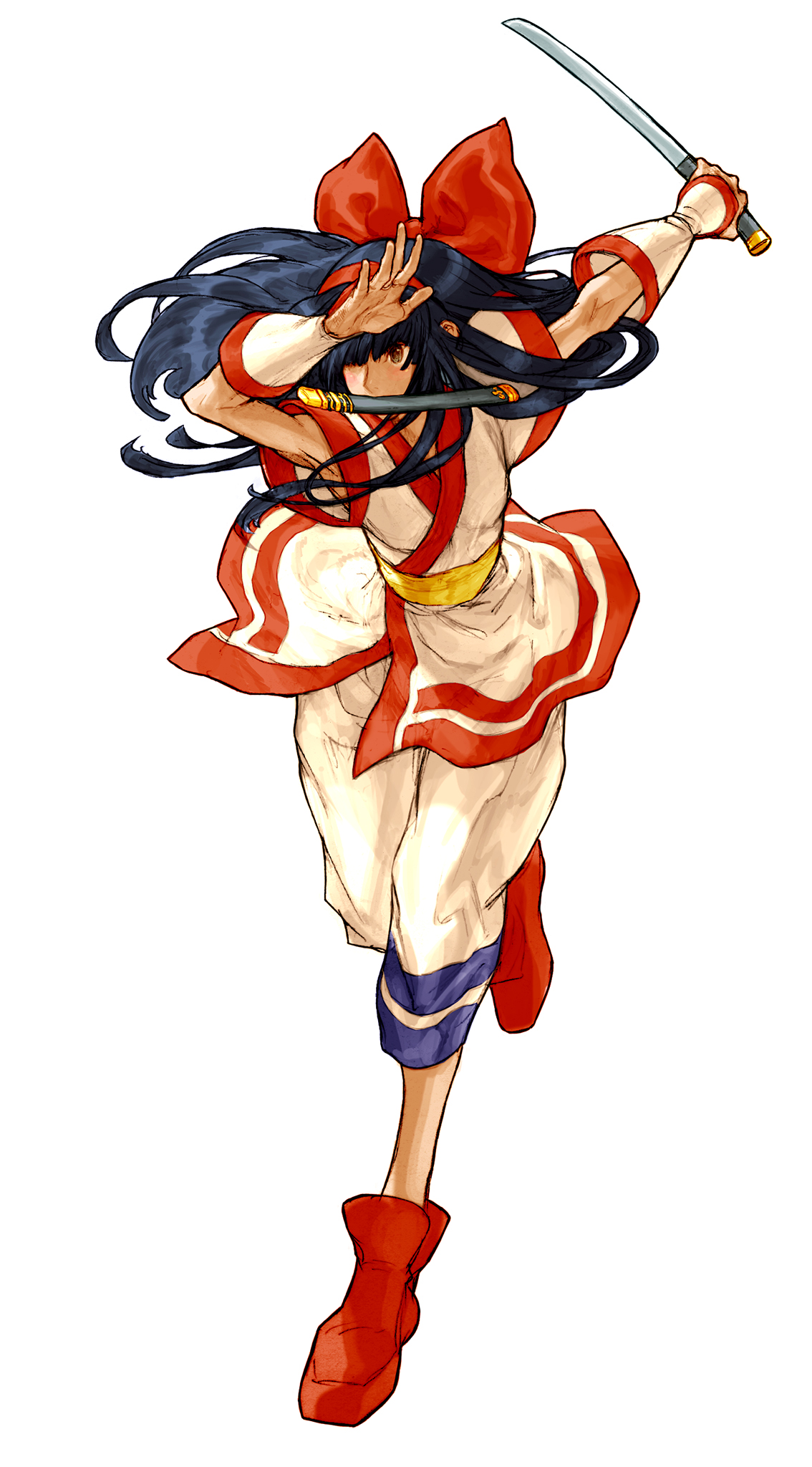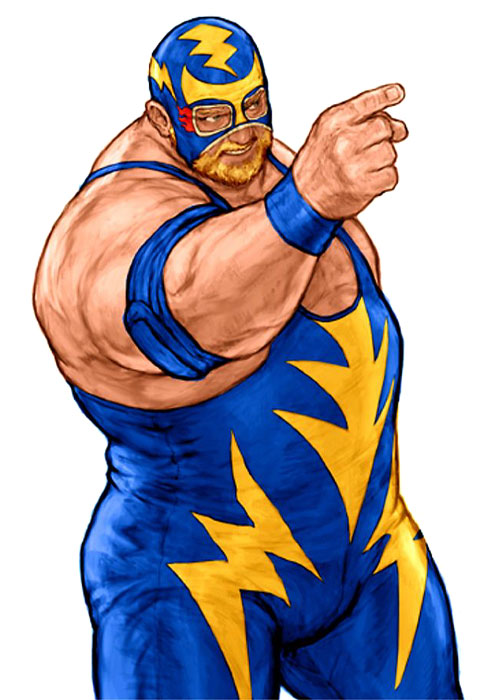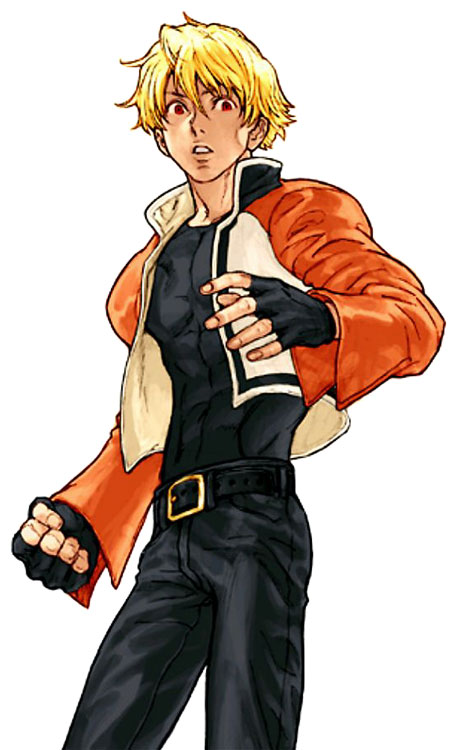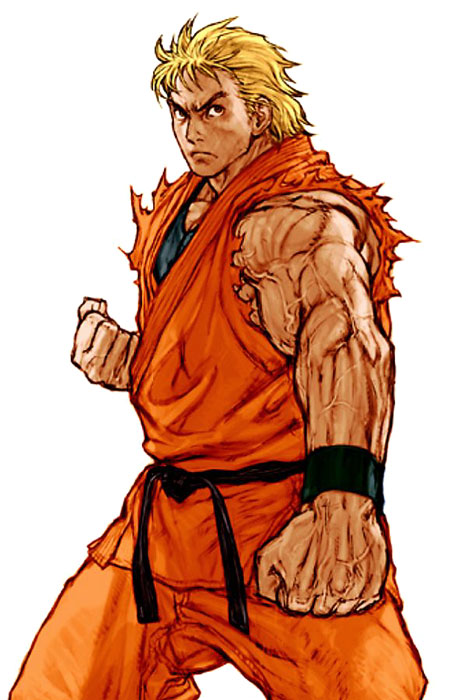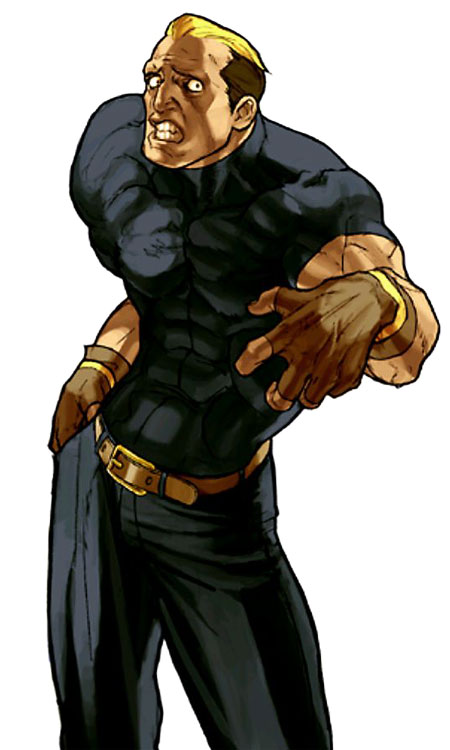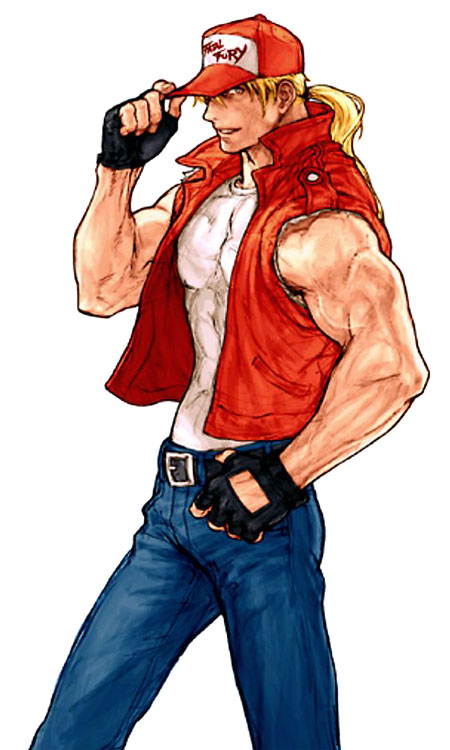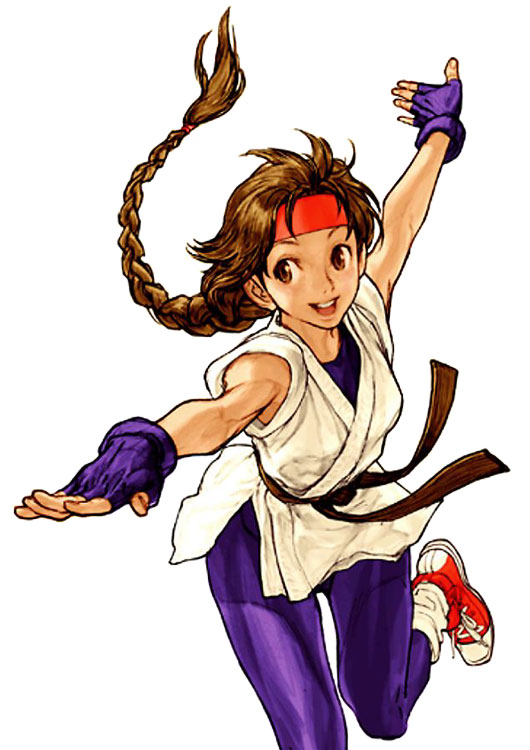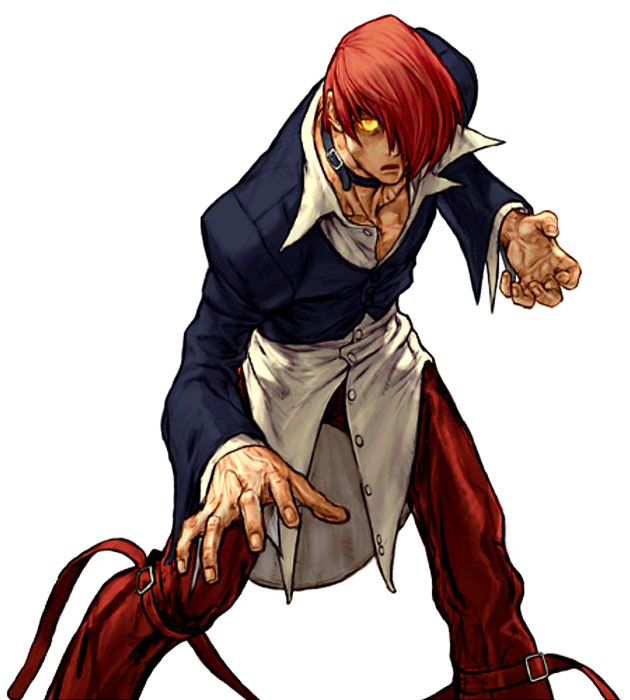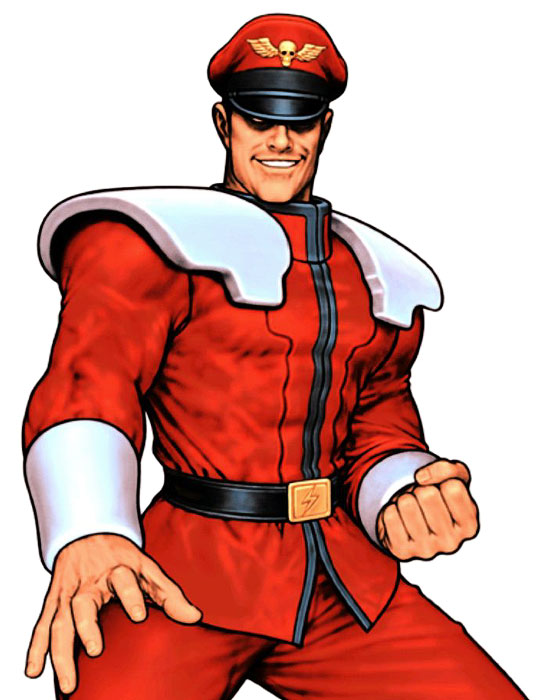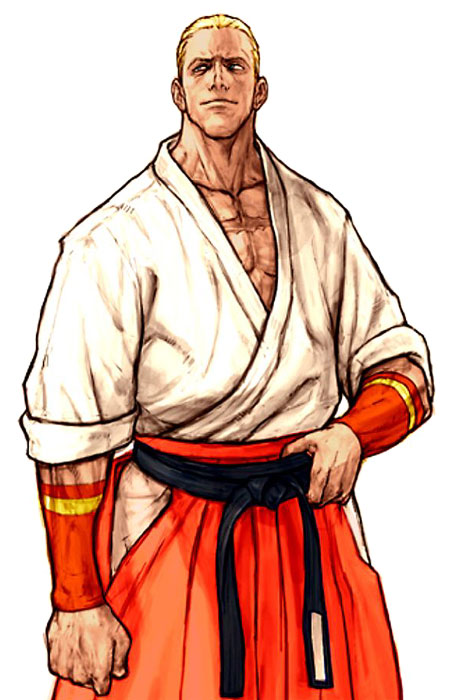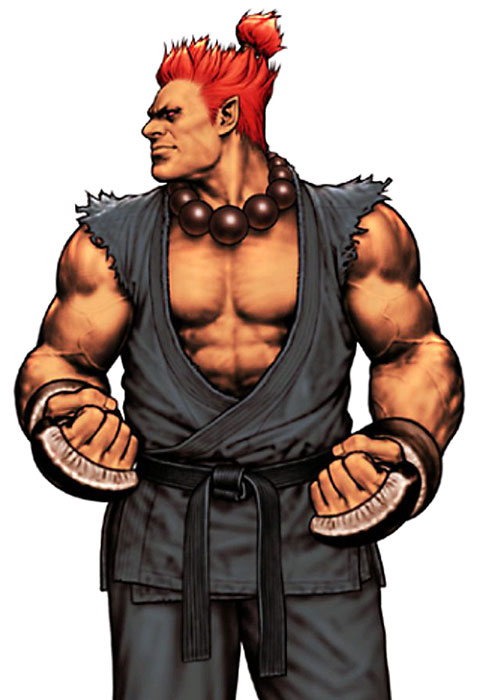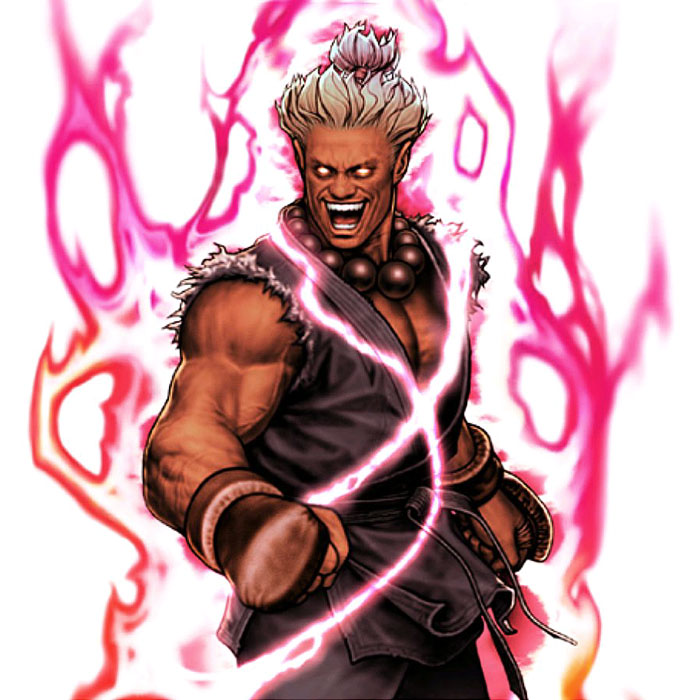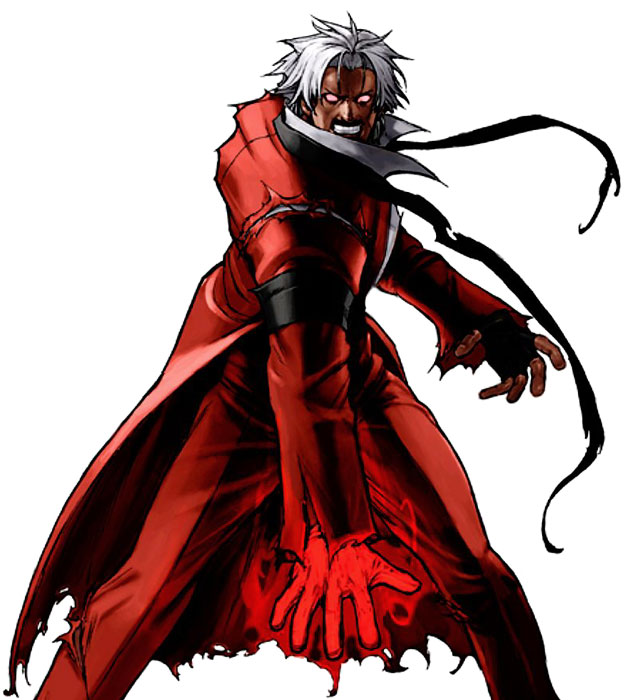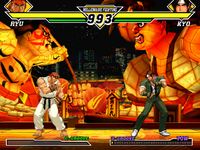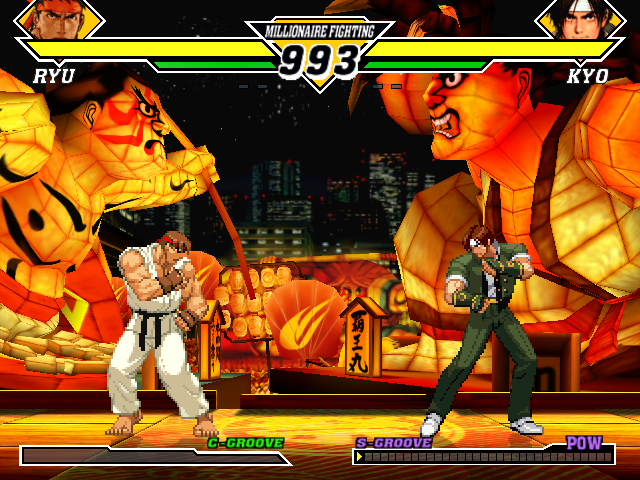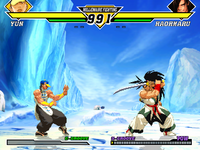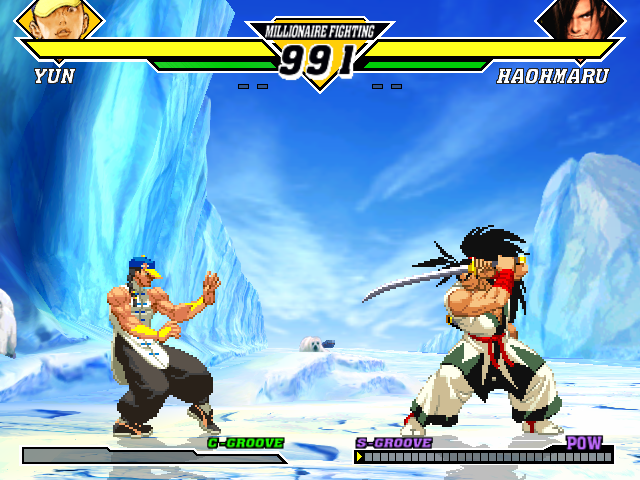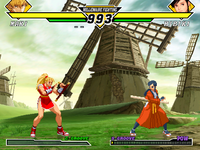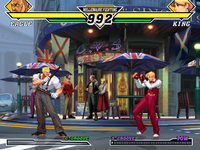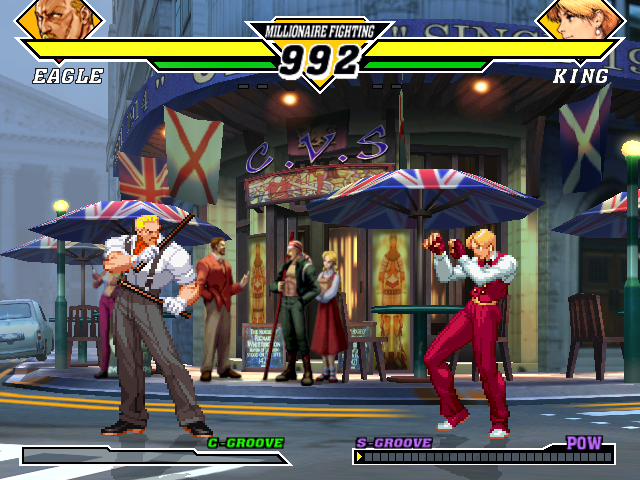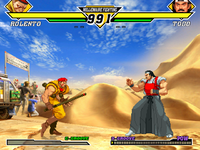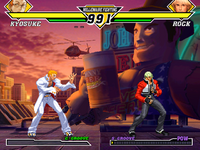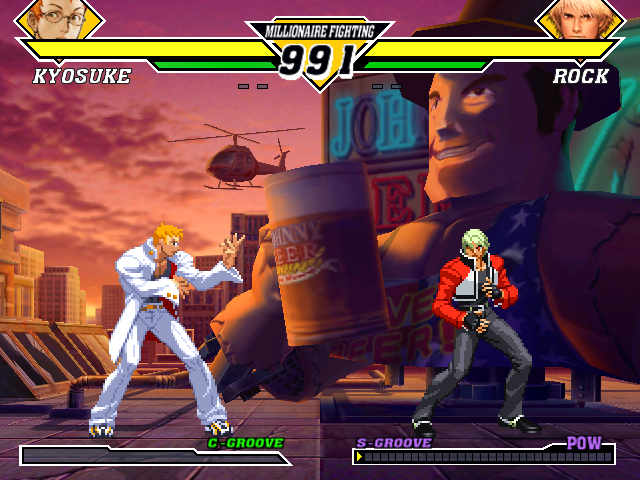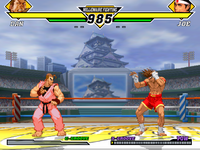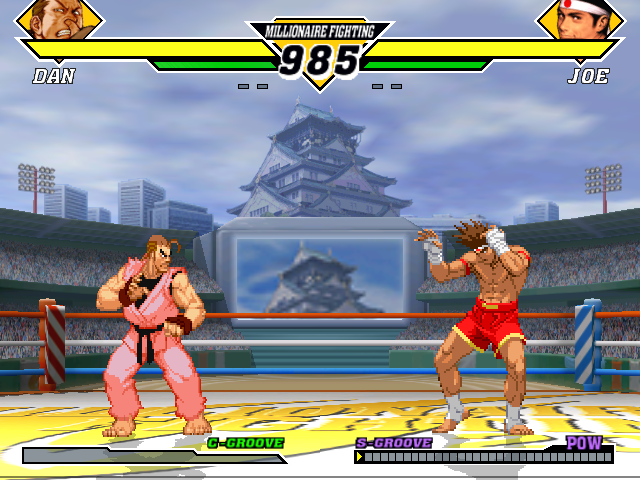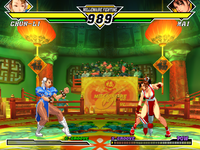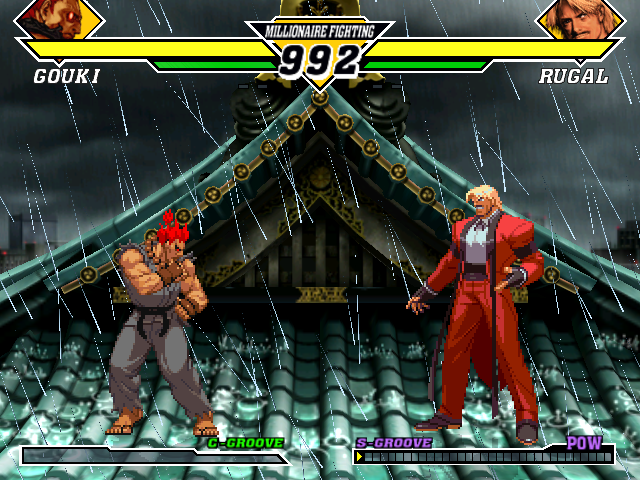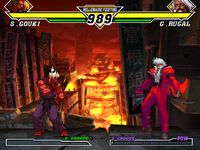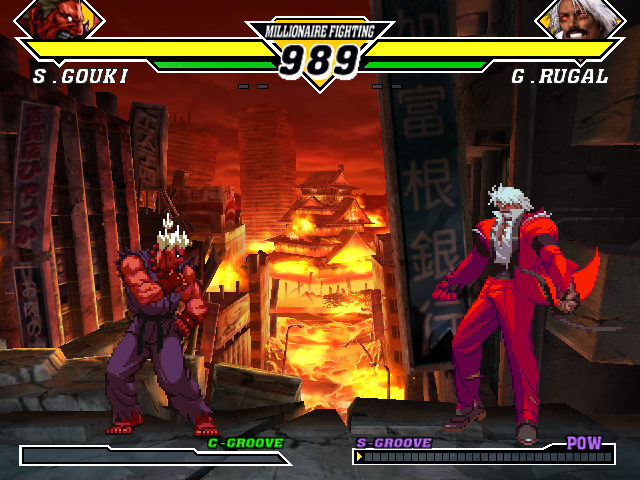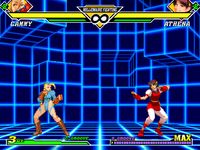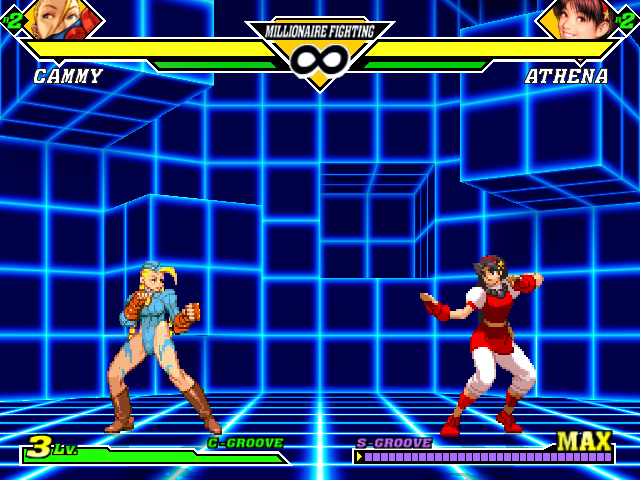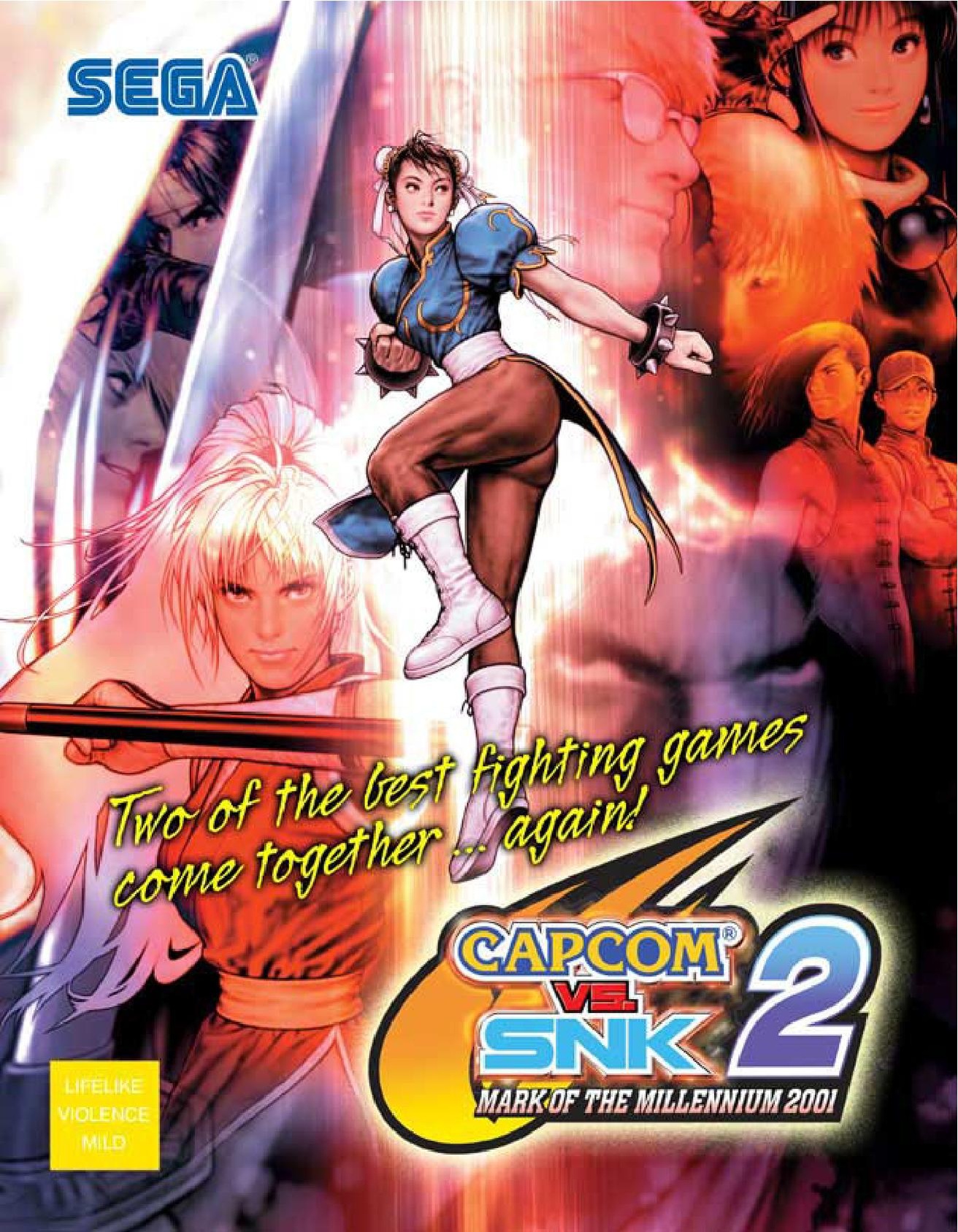Capcom vs. SNK 2 Millionaire Fighting 2001
From Sega Retro
| |||||||||||||||||||||||||||||||
| Capcom vs. SNK 2 Millionaire Fighting 2001 | |||||||||||||||||||||||||||||||
|---|---|---|---|---|---|---|---|---|---|---|---|---|---|---|---|---|---|---|---|---|---|---|---|---|---|---|---|---|---|---|---|
| System(s): Sega NAOMI, Sega NAOMI GD-ROM, Sega Dreamcast | |||||||||||||||||||||||||||||||
| Publisher: Capcom (JP) Sega (US) | |||||||||||||||||||||||||||||||
| Developer: Capcom | |||||||||||||||||||||||||||||||
| Licensor: SNK | |||||||||||||||||||||||||||||||
| Peripherals supported: Dreamcast Modem, Dreamcast VGA Box, Jump Pack, Dreamcast Arcade Stick, Dreamcast Keyboard, Neo Geo Pocket/Dreamcast Setsuzoku Cable, Visual Memory Unit | |||||||||||||||||||||||||||||||
| Genre: Fighting/Taisen Kakutou (対戦格闘)[1][2], Action[3] | |||||||||||||||||||||||||||||||
| Number of players: 1-2 | |||||||||||||||||||||||||||||||
| |||||||||||||||||||||||||||||||
|
Capcom vs. SNK 2 Millionaire Fighting 2001 (カプコン バーサス エス・エヌ・ケイ 2 ミリオネア ファイティング 2001) is a 2D fighting game developed and published by Capcom as the direct sequel to Capcom vs. SNK: Millennium Fight 2000. It was released for Sega NAOMI arcade hardware in 2001, with the American arcade release distributed by Sega. It was subsequently ported to the Sega Dreamcast and PlayStation 2 later in the year.
Contents
Story
A year has passed since the original tournament known as Millennium Fight 2000. The Garcia Financial Clique and the Masters Foundation have once again decided to hold a fighting tournament, this time with a million dollar prize, called Millionaire Fighting 2001.
Gameplay
Capcom vs. SNK 2 is a 2D fighting game that combines characters and gameplay elements primarily from Capcom's Street Fighter and SNK's The King of Fighters series, with elements also taken from the Fatal Fury and Samurai Shodown series. The game uses 3D-rendered backgrounds, and several new characters have been added, pulled from more varied sources than the original game's roster. The number of attack buttons has been increased from four (as used in The King of Fighters) to six (as used in Street Fighter). Players can choose from six different fighting styles called "grooves," which mimic the mechanics of other Capcom and SNK games. The selected groove determines the character's power gauge as well as the availability of special techniques such as dashes, running, and guard cancels.
Like The King of Fighters, players assemble teams of multiple characters, which fight each other in one-on-one battles. In contrast to the fixed system of the original, players can now freely select characters and assign each of them a number from one to four that determines their relative strength. Teams now consist of up to three characters (as opposed to four in the first game); players can choose fewer than three characters, but the overall team ratio must total four. Players can choose the order in which their team's characters fight before every match. When a character is defeated, the next character in the team takes his or her place in the next round, and the winning team continues with the same character (with a segment of health restored in proportion to the time left over in the previous round). The match continues until every character on one of the teams is eliminated. There is also an option to play one-on-one matches to the best of three rounds, as in a conventional fighting game. If time runs out before a character can be defeated, the character with the most life remaining is the winner. Both characters are eliminated in the case of a draw.
Characters move with ![]() and
and ![]() and crouch with
and crouch with ![]() . They jump with
. They jump with ![]() and flip back and forth with
and flip back and forth with ![]() and
and ![]() . They can "super jump" (a faster and farther jump, trailed by afterimages) by pressing
. They can "super jump" (a faster and farther jump, trailed by afterimages) by pressing ![]() , then
, then ![]() ,
, ![]() , or
, or ![]() quickly. Characters can perform a light punch with
quickly. Characters can perform a light punch with ![]() , a medium punch with
, a medium punch with ![]() , and a hard punch with
, and a hard punch with ![]() , and they perform a light kick with
, and they perform a light kick with ![]() , a medium kick with
, a medium kick with ![]() , and a hard kick with
, and a hard kick with ![]() . Light attacks are quick but do light damage, while hard attacks do more damage but have a longer startup delay and recovery time. Special moves for each character are done by pairing specific directional combinations with an attack button. Characters can perform a taunt with HOLD
. Light attacks are quick but do light damage, while hard attacks do more damage but have a longer startup delay and recovery time. Special moves for each character are done by pairing specific directional combinations with an attack button. Characters can perform a taunt with HOLD ![]() START , which is a short animation during which the character is vulnerable to attack. Taunting fills the opponent's power gauge by a slight amount.
START , which is a short animation during which the character is vulnerable to attack. Taunting fills the opponent's power gauge by a slight amount.
Throws and grabs are done by holding ![]() or
or ![]() when near an opponent and pressing a strong punch or kick button. Some characters have midair throws as well. Grapple moves cannot be blocked (including special moves involving grappling), but a character can escape a throw and take no damage by likewise holding
when near an opponent and pressing a strong punch or kick button. Some characters have midair throws as well. Grapple moves cannot be blocked (including special moves involving grappling), but a character can escape a throw and take no damage by likewise holding ![]() or
or ![]() and pressing a strong punch or kick button immediately upon being grabbed.
and pressing a strong punch or kick button immediately upon being grabbed.
Blocking is done by holding the D-Pad away from the opponent. Characters can block while standing, which blocks against high and mid attacks but not low attacks (such as sweeps), or crouching, which blocks against mid and low attacks but not high attacks (such as jumping attacks and overhead strikes). Special moves still do a small amount of "chip damage" if blocked. If characters block too much, they become "guard crushed" and momentarily stunned and vulnerable to attack; there is a guard gauge under the health gauge that shows how close the character is to being guard crushed. The guard gauge replenishes over time if the character does not block, and it fully refills after it is emptied.
Characters can become dizzy from being attacked repeatedly; they are uncontrollable and vulnerable in this state but can recover more quickly by rapidly pressing back and forth on the D-Pad along with the attack buttons. It is also possible to escape grabs in this way.
Grooves
Players choose from six different playstyles before selecting their characters. Three are based on Capcom games, and three are based on SNK games.
| C | |
|---|---|
| This groove is based on A-ism in Street Fighter Alpha 3.
Characters can backstep or dash with This is the only groove that can air block by holding the D-Pad away from the opponent in midair. However, characters cannot air block against normal attacks from an opponent that is standing on the ground and cannot air block after performing an attack in the air. Characters have a three-tiered power gauge that fills as they perform normal attacks and special moves or take damage (including blocked attacks). When at least one level of the gauge has been filled, the character can perform a super move. There are three different levels of each super move, with higher levels generally hitting more times. Each level costs as many levels of the gauge as the level of the attack, and the level is decided by the strength of the button used to perform the move ( LP or LK for level 1, MP or MK for level 2, and HP or HK for level 3). Level 2 super moves can be canceled into a level 1 super move, which can sometimes do more overall damage than performing a level 3 super move for the same amount of gauge levels. If the power gauge has at least one level, the character can perform a counterattack to immediately cancel out of a block by pressing the medium punch and kick buttons ( | |
| A | |
| This groove is based on V-ism in Street Fighter Alpha 3.
Characters can backstep or dash with Characters have a two-tiered power gauge that fills as they perform normal attacks and special moves or take damage (including blocked attacks). When at least one level of the gauge has been filled, the character can perform a level 1 super move at the cost of one level of the gauge. When both levels of the gauge are full, characters can perform Custom Combos (Original Combos in the Japanese versions) by pressing the hard punch and kick buttons ( If the power gauge has at least one level, the character can perform a counterattack to immediately cancel out of a block by pressing the medium punch and kick buttons ( | |
| P | |
| This groove is based on Street Fighter III.
Characters can backstep or dash with Characters can parry incoming attacks by pressing the D-Pad toward the opponent to parry a high or mid attack or by pressing Characters have a single-level power gauge that fills as they perform normal attacks and special moves, parry, or take damage. The gauge fills more slowly than the other grooves. When it is full, characters can perform a level 3 super move at the cost of the entire gauge. | |
| S | |
| This groove is based on the Extra mode in The King of Fighters '98 (which is itself based on the playstyle of The King of Fighters '94 and The King of Fighters '95).
Characters can backstep or run with This is the only groove where characters can dodge attacks by pressing the light punch and kick buttons ( The power gauge is filled by blocking attacks or taking damage. It can also be charged by holding the strong punch and kick buttons ( While in "MAX mode," the character can perform a counterattack to immediately cancel out of a block by pressing the medium punch and kick buttons ( | |
| N | |
| This groove is based on the Advanced mode in The King of Fighters '98 (which is itself based on the playstyle of The King of Fighters '96).
Characters can backstep or run with The power gauge is filled by performing normal attacks and special moves or taking damage (including blocked attacks). When the gauge is filled, it is kept in stock and reset, up to three times. A character can use one stock of the gauge to perform a level 1 super move or to enter "MAX mode" by pressing the strong punch and kick buttons ( While in "MAX mode," the character can perform a counterattack to immediately cancel out of a block by pressing the medium punch and kick buttons ( | |
| K | |
| This groove combines the "Rage gauge" from Samurai Shodown with the Just Defend mechanic from Garou: Mark of the Wolves.
Characters can backstep or run with Blocking an attack at the moment before it hits is called a "Just Defend," which blocks the attack, replenishes a small amount of health, and recovers faster than a regular block (creating an opening for a counterattack). This can also be done in midair (unlike regular blocking). Characters have a single-level "Rage gauge" (怒), which only fills when the character is attacked or guards an attack with a Just Defend (but not a regular block). When the gauge fills completely, it starts draining, and the character turns red and gains a 35% bonus to attack damage and a 12.5% bonus to defense until it is emptied. While in this state, the character can perform a level 3 super move, which drains the rest of the gauge. |
Modes
The Dreamcast version of the game has multiple modes. As in the original Capcom vs. SNK, some options must be unlocked by acquiring "Groove Points." Groove Points are accumulated during single-player games by hitting opponents with attacks (with special moves and super moves earning more points), by using special mechanics (such as a guard break or Just Defend), or by defeating opponents. Finishing an opponent with a counterattack super move or by countering a super move with a special move is called a "Finest K.O." and worth 50 to 100 Groove Points. Getting hit or losing a match costs points. The number of Groove Points earned during a game is shown above the timer. The player's total amount of Groove Points is saved to a VMU.
- Arcade Mode: A single-player mode where the player forms a team of up to three characters and fights a series of elimination matches against five randomly selected teams, then against a final boss. The final boss is Rugal if the player is using a Capcom groove (C, A, or P) or Akuma if the player is using an SNK groove (S, N, or K). If the player fulfills certain requirements, an additional boss fight against Geese Howard (Capcom groove) or M. Bison (SNK groove) is unlocked before the fourth match. If the player fulfills more stringent requirements, a secret final fight against Ultimate Rugal (Capcom groove) or Shin Akuma (SNK groove) is unlocked after the last match. There are three formats for this mode: Ratio Match (players assemble teams of three with a combined ratio of four and fight an elimination match), 3-on-3 Match (players choose any three characters, which are all treated as having a ratio of one, and fight an elimination match), or Single Match (players choose one character, which is treated as having a ratio of two, and fight a match to the best of three rounds). The game ends if the player loses a match but can be continued an unlimited number of times. A second player can challenge the first by pressing START , with the victor of the match continuing the game. There are eight difficulty levels for computer-controlled opponents.
- Boss Battle Mode: After defeating both Ultimate Rugal and Shin Akuma at least once, a hidden boss battle mode is unlocked, which can be accessed by holding
 +
+ when starting the Arcade Mode. It is the same as the Arcade Mode, except it consists only of matches against the six boss characters (M. Bison, Geese Howard, Evil Ryu, Orochi Iori, Akuma, Rugal, Shin Akuma, and Ultimate Rugal). Completing this mode unlocks an "Extra Option" menu in the options.
when starting the Arcade Mode. It is the same as the Arcade Mode, except it consists only of matches against the six boss characters (M. Bison, Geese Howard, Evil Ryu, Orochi Iori, Akuma, Rugal, Shin Akuma, and Ultimate Rugal). Completing this mode unlocks an "Extra Option" menu in the options. - Survival Mode: A single-player mode where the player chooses a groove and a character and tries to defeat as many. characters as possible in one-round matches on a single health gauge. All combatants are treated as having a ratio of two. Some health is replenished after each round, depending on the player's score. The contents of the character's power gauge is carried over to the next match (except in the S groove). There are two formats for this mode: All Survival (where the player fights against every character in the game) and ∞ Survival (where the player fights against endless opponents until defeated).
- Vs Mode: A two-player mode where players pick a stage, their grooves, and their characters and fight each other. Each player can also set a handicap. The game keeps track of each player's wins, losses, and win ratio. As in the Arcade Mode, there are three formats for this mode: Ratio Match, 3-on-3 Match, or Single Match.
- Training Mode: A practice mode where the player chooses any character and any opponent and can choose a groove and a ratio (between one and four) for either character. The player can set the whether the dummy opponent is non-hostile, hostile, or controlled by a second control pad. Non-hostile opponents can be set to stand, crouch, or jump and guarding or not guard. The player can also toggle the health gauge (normal or flashing red) and power gauge (normal or max). The player can toggle the display of button presses and attack data.
- Groove Edit Mode: This move is unlocked after completing the game. This allows the player to create two custom grooves (EX1 and EX2) by mixing and matching elements of the default grooves. The resulting grooves can be saved to a VMU and used in any mode. The player can select any of the six different gauges (or no gauge), then toggle systems and subsystems from the existing grooves. However, all of these elements cost a different amount of Groove Points to unlock, and the player initially starts with 4,000 Groove Points.
- Color Edit Mode: A customization mode where the player can create custom color schemes for any character. Each character has 15 colors that can be changed (by adjusting the red, green, or blue color bars). Pressing START opens a menu with additional options. Custom color schemes can be saved to a VMU.
- Replay Mode: This mode allows the player to load and watch a replay of a match from a VMU. Players are given the chance to save replays after completing a match in the Vs Mode. A replay takes 30 blocks of storage.
- Network Mode: This mode supported competitive online matches over Capcom's Matching Service.
Characters
Note: Move lists assume that the character is facing right. When facing left, ![]() and
and ![]() should be reversed.
should be reversed.
| P | Any punch button |
| LP | Light punch |
| MP | Medium punch |
| HP | Hard punch |
| K | Any kick button |
| LK | Light kick |
| MK | Medium kick |
| HK | Hard kick |
| TAUNT | Taunt |
The game features a total of 48 playable characters, including the entire returning roster of Capcom vs. SNK Millennium Fight 2000 Pro.
Every character has a different color scheme depending on which button is used to select him or her (![]() ,
, ![]() ,
, ![]() ,
, ![]() ,
, ![]() , or
, or ![]() ). Additional bonus color schemes can be used by selecting the character with all three punch buttons (
). Additional bonus color schemes can be used by selecting the character with all three punch buttons (![]() +
+![]() +
+![]() ) or all three kick buttons (
) or all three kick buttons (![]() +
+![]() +
+![]() ). If the player has made a custom color scheme for the character in the Color Edit Mode, it can be selected with START .
). If the player has made a custom color scheme for the character in the Color Edit Mode, it can be selected with START .
Capcom
There are five new Capcom characters. Eagle appears for the first time since the original Street Fighter. Yun is added as the only new character from Street Fighter III (though Chun-Li is also updated to her 3rd Strike version). While the first Capcom vs. SNK only featured characters from the Street Fighter series (with the exception of Morrigan from Darkstalkers as a hidden character), this roster adds new characters from other series: Kyosuke Kagami from Rival Schools and Rolento and Maki from Final Fight (though Rolento appears as he did in Street Fighter Alpha 2).
Evil Ryu is exclusive to the console releases.
SNK
Athena Asamiya and Chang Koehan (with Choi Bounge) are added from The King of Fighters, Rock Howard is added from Garou: Mark of the Wolves, Haohmaru is added from Samurai Shodown, Hibiki Takane is added from The Last Blade 2, and Ryuhaku Todo is added from Art of Fighting (in his only playable appearance aside from the console ports of that game).
Orochi Iori is exclusive to the console releases.
|
Originally appeared in: Psycho Soldier
|
Athena Asamiya | ||||||||||||||||||||||||||||||||||||||||||||||||||
Athena is a Japanese pop idol with powerful psychic abilities and kung fu training.
| |||||||||||||||||||||||||||||||||||||||||||||||||||
|
Originally appeared in: The King of Fighters '94
|
Benimaru Nikaido | ||||||||||||||||||||||||||||||||||||||||||||||||||
Benimaru is a model with a Japanese father and an American mother who fights with shootboxing techniques and can control electricity.
| |||||||||||||||||||||||||||||||||||||||||||||||||||
|
Originally appeared in: The King of Fighters '94
|
Chang Koehan and Choi Bounge | ||||||||||||||||||||||||||||||||||||||||||||||||||
Chang and Choi are Korean criminals who were apprehended by Kim Kaphwan and forced to train in fighting as part of his "Rehabilitation Project." The player primarily controls Chang, with Choi following and contributing to some moves.
| |||||||||||||||||||||||||||||||||||||||||||||||||||
|
Originally appeared in:
|
Haohmaru | ||||||||||||||||||||||||||||||||||||||||||||||||||
Haohmaru is a wandering samurai who fights to improve himself and to challenge evildoers.
| |||||||||||||||||||||||||||||||||||||||||||||||||||
|
Originally appeared in:
|
Hibiki Takane | ||||||||||||||||||||||||||||||||||||||||||||||||||
Hibiki is an innocent but skillful swordswoman who is on a mission to avenge her father.
| |||||||||||||||||||||||||||||||||||||||||||||||||||
|
Originally appeared in:
|
Iori Yagami | ||||||||||||||||||||||||||||||||||||||||||||||||||
Iori is the heir to the Yagami clan, which sealed away the snake demon Orochi along with the Kusanagi and Yata clans. He can create fire, which is purple because of the blood pact his clan made with Orochi hundreds of years ago. He has an intense dislike of Kyo because of the longstanding feud between their clans.
| |||||||||||||||||||||||||||||||||||||||||||||||||||
|
Originally appeared in:
|
Joe Higashi | ||||||||||||||||||||||||||||||||||||||||||||||||||
Joe is a Japanese Muay Thai kickboxing champion and a friend of the Bogard brothers.
| |||||||||||||||||||||||||||||||||||||||||||||||||||
|
Originally appeared in:
|
Kim Kaphwan | ||||||||||||||||||||||||||||||||||||||||||||||||||
Kim is a taekwondo master with a strong sense of justice.
| |||||||||||||||||||||||||||||||||||||||||||||||||||
|
Originally appeared in:
|
King | ||||||||||||||||||||||||||||||||||||||||||||||||||
King is a French bar owner who fights with a unique form of Muay Thai incorporating numerous acrobatic spinning kicks.
| |||||||||||||||||||||||||||||||||||||||||||||||||||
|
Originally appeared in: The King of Fighters '94
|
Kyo Kusanagi | ||||||||||||||||||||||||||||||||||||||||||||||||||
Kyo is the heir to the Kusanagi clan, which sealed away the snake demon Orochi along with the Yagami and Yata clans. He is one of the last members of his clan who can still create fire.
| |||||||||||||||||||||||||||||||||||||||||||||||||||
|
Originally appeared in:
|
Mai Shiranui | ||||||||||||||||||||||||||||||||||||||||||||||||||
Mai is a kunoichi who was trained in her family's ninjutsu arts.
| |||||||||||||||||||||||||||||||||||||||||||||||||||
|
Originally appeared in:
|
Nakoruru | ||||||||||||||||||||||||||||||||||||||||||||||||||
Nakoruru is a young girl who is a guardian of nature.
| |||||||||||||||||||||||||||||||||||||||||||||||||||
|
Originally appeared in:
|
Raiden | ||||||||||||||||||||||||||||||||||||||||||||||||||
Raiden is a heel pro wrestler known for his ruthlessness in the ring.
| |||||||||||||||||||||||||||||||||||||||||||||||||||
|
Originally appeared in:
|
Rock Howard | ||||||||||||||||||||||||||||||||||||||||||||||||||
Rock is the son of Geese Howard, who was raised by Terry Bogard after his father's death.
| |||||||||||||||||||||||||||||||||||||||||||||||||||
|
Originally appeared in:
|
Ryo Sakazaki | ||||||||||||||||||||||||||||||||||||||||||||||||||
Ryo is a practitioner of Kyokugen-ryuu, a style of karate created by his father.
| |||||||||||||||||||||||||||||||||||||||||||||||||||
|
Originally appeared in:
|
Ryuhaku Todo | ||||||||||||||||||||||||||||||||||||||||||||||||||
Todo is a martial arts instructor who created his own style dervied from Aiki-juujutsu and Kendo.
| |||||||||||||||||||||||||||||||||||||||||||||||||||
|
Originally appeared in:
|
Ryuji Yamazaki | ||||||||||||||||||||||||||||||||||||||||||||||||||
Ryuji Yamazaki is a deadly and insane Japanese mobster who fights with one hand in his pocket.
| |||||||||||||||||||||||||||||||||||||||||||||||||||
|
Originally appeared in:
|
Terry Bogard | ||||||||||||||||||||||||||||||||||||||||||||||||||
Terry is a young American fighter who learned various fighting techniques from his father.
| |||||||||||||||||||||||||||||||||||||||||||||||||||
|
Originally appeared in:
|
Vice | ||||||||||||||||||||||||||||||||||||||||||||||||||
Vice is Rugal's sadistic secretary, who possesses preternatural strength.
| |||||||||||||||||||||||||||||||||||||||||||||||||||
|
Originally appeared in: Art of Fighting 2
|
Yuri Sakazaki | ||||||||||||||||||||||||||||||||||||||||||||||||||
Yuri is the younger sister of Ryo and a student of Kyokugen-ryuu.
| |||||||||||||||||||||||||||||||||||||||||||||||||||
|
Originally appeared in:
|
Orochi Iori | ||||||||||||||||||||||||||||||||||||||||||||||||||
Orochi Iori is a version of Iori when he is under the effects of the Riot of the Blood, due to the blood pact his clan made with Orochi hundreds of years ago that gave them greater powers but cursed the clan and their descendants forever.
|
Bosses
Shin Akuma and Ultimate Rugal were non-playable bosses in the original arcade version, but they become playable in the Dreamcast version after defeating them in the Arcade Mode.
|
Originally appeared in:
|
M. Bison (Vega) | ||||||||||||||||||||||||||||||||||||||||||||||||||||||||
M. Bison is the shadowy leader of the international crime syndicate Shadaloo. He is motivated solely by his lust for world domination and fights using a dark psychotic energy known as "Psycho Power." He can appear as a possible mid-boss before the fourth match if certain requirements are fulfilled.
| |||||||||||||||||||||||||||||||||||||||||||||||||||||||||
|
Originally appeared in:
|
Geese Howard | ||||||||||||||||||||||||||||||||||||||||||||||||||||||||
Geese is the mafia kingpin of South Town and the nemesis of the Terry Bogard. He is an American who has studied and mastered Japanese fighting techniques. He can appear as a possible mid-boss before the fourth match if certain requirements are fulfilled.
| |||||||||||||||||||||||||||||||||||||||||||||||||||||||||
|
Originally appeared in:
|
Akuma (Gouki) | ||||||||||||||||||||||||||||||||||||||||||||||||||||||||
Akuma is a savage and merciless fighter who has mastered the Satsui no Hadou. He is the final boss of the game when playing with an SNK groove.
| |||||||||||||||||||||||||||||||||||||||||||||||||||||||||
|
Originally appeared in: The King of Fighters '94
|
Rugal Bernstein | ||||||||||||||||||||||||||||||||||||||||||||||||||||||||
Rugal is a cruel and sophisticated crime lord who turns the fighters he defeats into living trophies. He is the final boss of the game when playing with a Capcom groove.
| |||||||||||||||||||||||||||||||||||||||||||||||||||||||||
|
Originally appeared in:
|
Shin Akuma (Shin Gouki) | ||||||||||||||||||||||||||||||||||||||||||||||||||||||||
Shin Akuma is a version of Akuma that represents him when he becomes almost one with the Satsui no Hadou. If certain requirements are fulfilled, he appears as the hidden final boss when using an SNK groove.
| |||||||||||||||||||||||||||||||||||||||||||||||||||||||||
|
Originally appeared in:
|
Ultimate Rugal (God Rugal) | ||||||||||||||||||||||||||||||||||||||||||||||||||||||||
Ultimate Rugal is a version of Rugal that was revived with a small parcel of Orochi's blood. If certain requirements are fulfilled, he appears as the hidden final boss when using a Capcom groove.
|
Stages
Stages are chosen randomly for most matches in the Arcade Mode. The final bosses Akuma or Rugal are always fought in the Osaka Tower Rooftop stage, and the secret bosses Shin Akuma or Ultimate Rugal are always fought in the Osaka in Flames stage.
The stage can be chosen manually in the Vs Mode and Training Mode. There is a special Training Room stage that can be selected in these modes.
History
Development
Character sprites
Because Capcom vs. SNK 2 features a roster composed of characters from numerous games and hardware eras, the appearances of several of Capcom's characters have been considered substandard in comparison to the newly drawn SNK characters. Instead of choosing to redraw its characters, Capcom took the approach of reusing old character sprites from previous games and inserting them in among the other characters.
The result created a significant disparity, particularly in the case of characters like Morrigan, whose low-resolution sprite from the original Darkstalkers games appears washed out and lacking in detail when compared to Capcom's newly drawn characters, such as Maki, Eagle, Ryu, Ken, and Vega (M. Bison). Chun-Li and Yun also have new sprites, based on their CPS-3 sprites from the Street Fighter III series. This has led to criticism of Capcom's art department.
Cross-platform play
During its development, Capcom worked with KDDI to bring a cross-platform online Matching Service for Capcom vs. SNK 2, allowing, at launch, for Dreamcast owners to fight against PlayStation 2 owners of the game (exclusively in Japan). To achieve this, the Dreamcast could connect to KDDI's servers with its built-in modem, while the PlayStation 2 was forced to use an external modem (which Capcom bundled in a special package). This is the first of two known Dreamcast games to support cross-platform console play, the other being Kidou Senshi Gundam: Renpou vs. Zeon & DX, also developed by Capcom.
The specifics remain unclear, however Capcom vs. SNK 2's launch on 13 September 2001 potentially makes it not only the first PlayStation 2 game to support any kind of cross-platform online play, but also the first PlayStation 2 game to support online play at all, pre-dating the likes of Tony Hawk Pro Skater 3 (which currently holds a Guinness World Record for this feat[4]) by more than a month.
Sequels and re-releases
Though the Dreamcast version of the game remained exclusive to Japan, the arcade version was brought overseas as Capcom vs. SNK 2: Mark of the Millennium 2001. Other Western ports have retained that name. The Nintendo GameCube and Xbox received an upgraded version, called Capcom vs. SNK 2 EO (for "Easy Operation"), making the game one of the few titles to be released for all four platforms of that console generation.
Production credits
Dreamcast version
- Planner: Neo_G (H. Ishizawa), Takechan♥, ☆Oni-Suzuki☆, Mitsuaki Araki, Haman♥Satoru, Buruma (Kojimax)
- Visual Planner: Haruo Murata, Tomonori Ohnuma
- Programmer: Hyper Shinchan, Senor, Hard.Yas -Groove-, Yu Kawamura, Yanagi, Kumiko Morita, tencho, Yoji Mikami, ♥Nae♥Cham♥
- Network Programmer: Tomohiro Ueno, Batayon, Masao Matsumoto, Miss, Tetsuy@ Koide, Kentaro★Kaneko, Kaz Yunde, Jun Matsumoto, Shin., Kohei Akiyama
- A.C.R. Programmer: Meijin, Hiro, Kobuta, Okaz@Kagawa, Kazuhito Nakai, Masakazu Matsusita, Hirotaka.A, Mikio, Hiroaki Watanabe, Shinichi.Y, Soji Seta, Zag2001, Kuwana, Katsumi Aoki
- Title Designer: Ukabin
- Illustrator: Kinu Nishimura, Shinkiro, Ikeno, Capcom Design Team
- Instruction Card Designer: Sakomizu, M★Ru, Y.Uchida
- Object Designer: G・Kamina, Zzak, Ikusan Z, akA maniA, Chimorin Shogun, Jun ★ Ikawa, Tomohiko Ohsumi, ★toshi@loveyuko★, RVT1000R (RC51), Yamancha, Hideya Takada, Rinboku, Hiranodaichi, Masatsugu Sato, Yoshihiko, Yo-He, A-Ko, Kana, Nara
- Effect Designer: Takep, Anz
- Background Designer: Chika Iwai, Yuki Kyotani, Tama, Saru, Kuwajima@C-ya, Goro Suzuki 2001, Inoyan, Naoko Niiyama, Ryo Uno, Akiko Hongou, Aya Saito, Takako Nakamura, Kisabon, Chie Morisaki, Akiko Ohnishi, Youichi Tanoue, Yasuhiro Yamamoto, Hiroyuki Imahori, Masanori Kajita
- Music Composer: Satoshi Ise
- Sound Designer: Masayuki Endo
- Recording Engineer: Kazuya Takimoto
- Dj: Hiroaki Asai
- Director: Hideaki Itsuno
- Assistant Producer: Takayoshi Terada, Kenji Itsuno
- Producer: Yoshihiro Sudo
- General Producer: Noritaka Funamizu
- Executive Producer: Yoshiki Okamoto
- Special Thanks: Yasuhiro Kobayashi, Eiichi Yaji, H.Furubeppu, Kensuke Nakahara, kokoro, J.Nagai, Hagee, Akuta, Ojee, Shouden, Naoto Satou, Tsutomu Ikai, Yuriko Yamamoto, Michiyo Aoki, Takuya Shiraiwa, Shizuku Abe, Kaori Funyakoshi, Ayumi Comebara, Erik Genazea Suzuki, D44 (Bas), Knnit, Nuki♥Black, Xiao, Dr.seno, Toshitaka Kawamoto, Kiyomatu★teacher, Ume-Zono, Bugcheck Team, Sarugakucho, Junnosuke Miyamoto, Akira Tateishi, Kouta Sasaki, Tatsuya Hasegawa, Kazuo Shouno, Hideki Ishizuka, Kohji Okada, Jinichi Tokutomi, Toshihiro Komiya, Takashi Kikuchi, Hiroshi Terada, Masafumi Chigusa, Ryuuji Kida, Jun Tamura, All SNK Staff, All Capcom Staff. ...And You
Digital manuals
Magazine articles
- Main article: Capcom vs. SNK 2 Millionaire Fighting 2001/Magazine articles.
Promotional material
Artwork
- Main article: Capcom vs. SNK 2 Millionaire Fighting 2001/Artwork.
Physical scans
NAOMI version
| NAOMI, JP | ||||
|---|---|---|---|---|
| NAOMI GD-ROM, JP | ||||
|---|---|---|---|---|
Error creating thumbnail: convert: Insufficient memory (case 4) `/home/sonicret/domains/segaretro.org/public_html/images/9/90/Capcom_Vs_SNK_2_NAOMI_JP_Marquee.jpg' @ error/jpeg.c/JPEGErrorHandler/338. Error code: 1 "Top" instructions | ||||
Dreamcast version
| Sega Retro Average | ||||||||||||||||||||||||||||||||||||||||||||||||||||||
|---|---|---|---|---|---|---|---|---|---|---|---|---|---|---|---|---|---|---|---|---|---|---|---|---|---|---|---|---|---|---|---|---|---|---|---|---|---|---|---|---|---|---|---|---|---|---|---|---|---|---|---|---|---|---|
|
| 85 | |
|---|---|
| Based on 10 reviews | |
| Dreamcast, JP (Dorikore) |
|---|
|
Technical information
ROM dump status
| System | Hash | Size | Build Date | Source | Comments | |||||||||
|---|---|---|---|---|---|---|---|---|---|---|---|---|---|---|
| ? |
|
GD-ROM (JP) |
External links
- Sega of Japan catalogue pages (Japanese): Dreamcast
References
- ↑ File:CvS2 DC JP Box back.jpg
- ↑ 2.0 2.1 2.2 2.3 2.4 http://sega.jp/dc/010912/ (Wayback Machine: 2007-05-18 09:38)
- ↑ https://sega.jp/history/hard/dreamcast/software_l.html#tab02 (Wayback Machine: 2020-02-01 22:57)
- ↑ http://www.guinnessworldrecords.com/world-records/first-playstation-2-game-to-support-online-play/ (Wayback Machine: 2015-09-13 03:22)
- ↑ File:Capcom vs SNK 2 DC credits.pdf
- ↑ 100% Consoles, "Décembre 2001" (FR; 2001-1x-xx), page 71
- ↑ Consoles +, "Novembre 2001" (FR; 2001-1x-xx), page 88
- ↑ Dorimaga, "2001-08 extra (2001-09-21)" (JP; 2001-09-07), page 35
- ↑ Dorimaga, "2002-18 (2002-10-11)" (JP; 2002-09-27), page 33
- ↑ Famitsu, "2001-09-21" (JP; 2001-09-07), page 100
- ↑ GamesMaster, "January 2002" (UK; 2001-12-20), page 99
- ↑ MAN!AC, "12/2001" (DE; 2001-11-07), page 50
- ↑ Play, "Grudzień 2001" (PL; 2001-xx-xx), page 30
- ↑ PSX Extreme, "10/2001" (PL; 2001-1x-xx), page 49
- ↑ Strana Igr, "Noyabr 2001 2/2" (RU; 2001-xx-xx), page 67
| Capcom vs. SNK 2 Millionaire Fighting 2001 | |
|---|---|
|
Main page | Comparisons | Development | Magazine articles | Reception | Artwork | Technical information | Bootlegs | |
| Capcom vs. games for Sega systems | ||
|---|---|---|
| X-Men vs. Street Fighter (1997) | Marvel Super Heroes vs. Street Fighter (1998) | ||
| Marvel vs. Capcom: Clash of Super Heroes (1999) | Marvel vs. Capcom 2: New Age of Heroes (2000) | Capcom vs. SNK: Millennium Fight 2000 (2000) | Capcom vs. SNK Millennium Fight 2000 Pro (2001) | Capcom vs. SNK 2 Millionaire Fighting 2001 (2001) | ||
| Related Games | ||
| X-Men: Children of the Atom (1995) | Marvel Super Heroes (1997) | ||
| The King of Fighters games for Sega systems or published by Sega | |
|---|---|
| The King of Fighters '95 (1996) | The King of Fighters '96 (1996) | The King of Fighters '96 + '95: Gentei KOF Double Pack (?) | The King of Fighters '97 (1998) | The King of Fighters Best Collection (1998) | |
| The King of Fighters: Dream Match 1999 (1999) | The King of Fighters: Evolution (2000) | The King of Fighters 2000 (2002) | The King of Fighters 2001 (2002) | The King of Fighters 2002 (2003) | |
| The King of Fighters Neowave (2004) | The King of Fighters XI (2005) | |
| The King of Fighters XIV (2016) | |
| Unlicensed The King of Fighters games for Sega systems | |
| King of Fighters 98' (1998) | The King of Fighters '99 (1999) | |
| Related games | |
| Capcom vs. SNK: Millennium Fight 2000 (2000) | Capcom vs. SNK Millennium Fight 2000 Pro (2000) | Capcom vs. SNK 2 Millionaire Fighting 2001 (2001) | NeoGeo Battle Coliseum (2005) | SNK Heroines: Tag Team Frenzy (2018) | |
- Dreamcast Arcade Stick-compatible games
- Dreamcast Keyboard-compatible games
- Jump Pack-compatible games
- Dreamcast Modem-compatible games
- Neo Geo Pocket/Dreamcast Setsuzoku Cable-compatible games
- Dreamcast VGA Box-compatible games
- Visual Memory Unit-compatible games
- 1-2 player games
- All arcade games
- NAOMI games
- 2001 NAOMI games
- All 2001 games
- NAOMI GD-ROM games
- 2001 NAOMI GD-ROM games
- JP Dreamcast games
- All JP games
- Dreamcast games
- 2001 Dreamcast games
- Dreamcast fighting games
- All fighting games
- Dreamcast games with ADX audio
- Dreamcast games using Flash
- All games
- Missing ROM hashes
- Old technical information
- Capcom vs. SNK 2 Millionaire Fighting 2001
- Capcom vs.
- The King of Fighters
